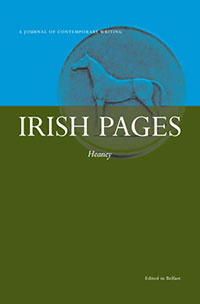 Edited by Chris Agee and Cathal Ó Searcaigh, the newest issue of Irish Pages (v8 n 2) is a tribute in memory of Seamus Heaney. The journal includes: four poems by Heaney; Sven Birkerts and Helen Vendler on the man and the poet; a suite of obituaries and global reminiscences by leading poets and writers in Ireland, Britain and the United States; new poems by Kerry Hardie, Michael Coady, Paddy Bushe, Kathleen Jamie, Katie Donovan, Seán Lysaght, Damian Smyth, Ignatius McGovern, John F. Deane, Franics Harvey, Michael Longley, Alan Gillis, Moya Cannon and Harry Clifton; President Michael D. Higgins on John Hewitt & Richard Murphy on poetry and terror; new writing in Irish from Nuala Ní Dhomhnaill, Cathal O Searcaigh and others; and Seamus Justin Heaney 1939-2013 a unique photographic portfolio by Bobbie Hanvey.
Edited by Chris Agee and Cathal Ó Searcaigh, the newest issue of Irish Pages (v8 n 2) is a tribute in memory of Seamus Heaney. The journal includes: four poems by Heaney; Sven Birkerts and Helen Vendler on the man and the poet; a suite of obituaries and global reminiscences by leading poets and writers in Ireland, Britain and the United States; new poems by Kerry Hardie, Michael Coady, Paddy Bushe, Kathleen Jamie, Katie Donovan, Seán Lysaght, Damian Smyth, Ignatius McGovern, John F. Deane, Franics Harvey, Michael Longley, Alan Gillis, Moya Cannon and Harry Clifton; President Michael D. Higgins on John Hewitt & Richard Murphy on poetry and terror; new writing in Irish from Nuala Ní Dhomhnaill, Cathal O Searcaigh and others; and Seamus Justin Heaney 1939-2013 a unique photographic portfolio by Bobbie Hanvey.
Able Muse Prize Winners & Featured Poet
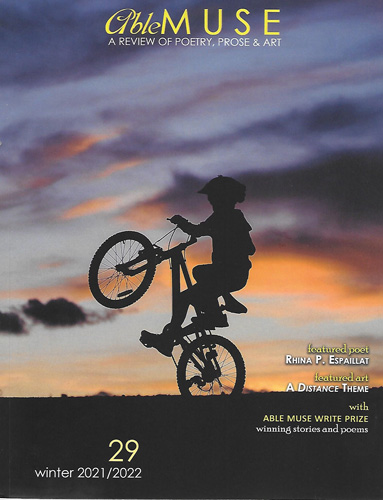 Able Muse Winter 2014 features poetry from Scott M. Miller, winner of the 2014 Write Prize for Poetry, as well as by finalists Eric Berlin, Marilyn L. Taylor, and Catherine Chandler. Winning work of the 2014 Write Prize for Fiction, J. Preston Witt, is featured as well.
Able Muse Winter 2014 features poetry from Scott M. Miller, winner of the 2014 Write Prize for Poetry, as well as by finalists Eric Berlin, Marilyn L. Taylor, and Catherine Chandler. Winning work of the 2014 Write Prize for Fiction, J. Preston Witt, is featured as well.
New to this issue, Able Muse includes a Featured Poet. Wendy Videlock is the inaugural author to receive this honor, having five new poems published within and an interview with David Mason. Videlock shares her perspectives on sound and silence, the use of and movement away from the first-person pronoun, the conscious and the subconscious, and much more on her craft of writing.
Lit Mag Covers :: Picks of the Week
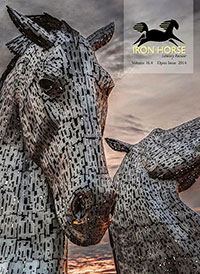
Amy Eavou’s cover photo for Iron Horse Literary Review (v16.6), appropriate for this time of year, is likewise aptly titled “Snowy Horse Muzzle.”
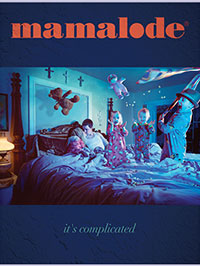
Mamalode‘s cover photo by Holly Andres provides the visual understatement of the year for the publication’s December theme: “It’s Complicated.”
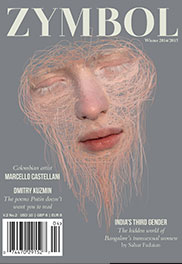
Marcello Castellani‘s “Dualidad Prismatica 2” print on canvas creates a stunning cover image for the winter 2014/2015 issue of Zymbol.
Glimmer Train Very Short Fiction Award Winners :: December 2014
Glimmer Train has just chosen the winning stories for their Very Short Fiction Award. This competition is held quarterly and is open to all writers for stories with a word count under 3000. The next Very Short Fiction competition will take place in January. Glimmer Train’s monthly submission calendar may be viewed here.
 First place: Eva Lomski [pictured], of Melbourne, Australia, wins $1500 for “The Things We Build.” Her story will be published in Issue 96 of Glimmer Train Stories.
First place: Eva Lomski [pictured], of Melbourne, Australia, wins $1500 for “The Things We Build.” Her story will be published in Issue 96 of Glimmer Train Stories.
Second place: Francisco Delgado, of Forest Hills, NY, wins $500 for “International Politics.” His story will also be published in an upcoming issue, increasing his prize to $700.
Third place: Chris Santiago, of Pasadena, CA, wins $300 for “Flyover Country.”
A PDF of the Top 25 winners can be found here.
Deadline coming up for the Glimmer Train Fiction Open: January 2
Glimmer Train hosts this competition twice a year, and first place is $2500 plus publication in the journal. This category has been won by both beginning and veteran writers – all are welcome! There are no theme restrictions. Word count generally ranges from 2000 – 8000, though up to 20,000 is fine. Click here for complete guidelines.
Stoneboat Polar Plunge
Sheboygan, Wisconsin is known to us Michganders as the place that breaks the winter storms for us before they head across Lake Michigan to our western shores. Which makes the Stoneboat fundraiser one that truly earns my respect for those kuh-ray-zee editors: On New Year’s Day, they will be participating in the Polar Bear Plunge. For those of you in warmer climates who may not be aware of what this entails – imagine filling your bathtub with ice water, strip down to next to nothing… Enough said, right? Feeling the chill already?
The folks at Stoneboat will be plunging into frigid Lake Michigan, or at least going in as deep as their fundraising demands. Which is where you come in: The more money Stoneboat raises before the January 1 plunge, the further they will submerge themselves into the water. Here’s their formula of how much and how deep they’ll go:
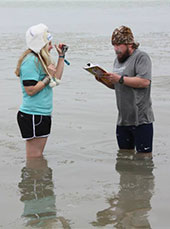 $50 knees
$50 knees
$100 mid-thighs
$150 hips
$200 belly buttons
$250 chests
$300 shoulders
In addition, while they’ll take donations in any amount, they are offering the following premiums to donors:
$10 a handmade Stoneboat bookmark
$20 a Stoneboat t-shirt
$50 a one-year subscription to Stoneboat and a poem of your choice (the first 10 lines, or the whole poem if it is 10 lines or less) will be read in the water/at the event*
The asterisk, fairly enough, ensures that no one succumb to hypothermia: “*We will try to read as many poems in the water as possible, and we’ll ensure that all selections are read at the event.”
So if you’re still looking for a post-holiday gift for someone, I’d say the subscription and having the poem read (and recorded) at this event would be a great way to head on in to 2015. Get those Stoneboaters up to their shoulders; really, I think this is one freeze they’d appreciate!
Antigonish Review Contest Winners
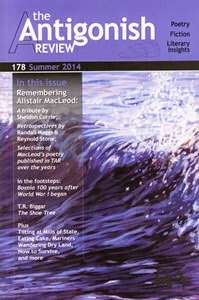 The newest issue of The Antigonish Review features winning works for two of the publication’s 2014 contests:
The newest issue of The Antigonish Review features winning works for two of the publication’s 2014 contests:
14th Great Blue Heron Poetry Contest
Judges: Patricia Young and Peter Sanger
First Prize: Harold Hoefle, St-Anne-de-Bellevue, QC
Second Prize: Michael Prior, Toronto, ON
Third Prize: Joanna Lilley, Whitehorse, YT
10th Sheldon Currie Fiction Contest
Judges: Joan Baril, Reynold Stone, Gwen Davies and Heather Debling
Final Judge: Sheree Fitch
First Prize: Jen Julian, Columbia, MO
Second Prize: John O’Neill, Toronto, ON
Third Prize: Ryan Frawley, Edmonton, AB
NewPages Literary Magazine Reviews
After the hustle and bustle of whatever it is you’re doing this holiday season, relax, unwind, pop the top off your favorite beverage, and enjoy some of the finest literary magazine review writing anywhere. NewPages reviewers take a thorough and critical look at the newest issues of both print and online literary magazines from around the globe. December’s reviews feature and eclectic mix: Arroyo Literary Review, Atlanta Review, The Carolina Quarterly, The Common, The Florida Review, The Lindenwood Review, The Meadow, North Carolina Quarterly Review, Pacifica Literary Review, Pembroke Magazine, Quiddity, Skidrow Penthouse, Upstreet, and The Westchester Review. Whew! And if that’s not enough, we have a full archive of past months’ reviews and a full index of all the magazines we’ve reviewed over the past ten+ years. Enjoy!
Rattle Poetry Prize
Disability and Poetry
 Disability and Poetry is the topic of discussion in the Poetry December 2014 feature “Exchange.” Writers Jennifer Bartlett, John Lee Clark, Jim Ferris, and Jillian Weise share views on writing disability, publishing, accessibility, and form and embodiment. There are some startlingly hard-hitting statments, such as Bartlett’s “I have resisted the term ‘identity poet’ when considering my own work; therefore, my biggest challenge is to address my cerebral palsy without poetics and other identities taking a ‘back seat’ in the process.” And later, “I think publishing in poetry is inherently biased; it always will be.”
Disability and Poetry is the topic of discussion in the Poetry December 2014 feature “Exchange.” Writers Jennifer Bartlett, John Lee Clark, Jim Ferris, and Jillian Weise share views on writing disability, publishing, accessibility, and form and embodiment. There are some startlingly hard-hitting statments, such as Bartlett’s “I have resisted the term ‘identity poet’ when considering my own work; therefore, my biggest challenge is to address my cerebral palsy without poetics and other identities taking a ‘back seat’ in the process.” And later, “I think publishing in poetry is inherently biased; it always will be.”
Or how about Ferris’s “Disability is dangerous. We represent danger to the normate world, and rightly so. Disabled people live closer to the edge. We are more vulnerable, or perhaps it is that we show our human vulnerability without being able to hide it in the ways that nondisabled people can hide and deny the vulnerability that is an essential part of being human.”
The exchange is hard core honest (editors and publishers should be reading this), as well as enlightening for all (including literary event planners). The Exchange is available full-text online here.
Lit Mag Covers :: Picks of the Week

There is just something I can appreciate from such an austre image on the front of a magazine – the kind that draws me in, though I can’t quite say why, and makes it hard to look away. This image on the cover of Brick #94 is a photograph of East Jerusalem street scene by Teju Cole. Though it looks black and white, it is in full color.
 I selected this cover image on Green Mountains Review (v27 n2) because the artist, Nancy Dwyer, is featured within the publication as well with a portfolio entitled, “Words are the Furniture of the Mind.” Eight full-color images are featured in addition to this cover.
I selected this cover image on Green Mountains Review (v27 n2) because the artist, Nancy Dwyer, is featured within the publication as well with a portfolio entitled, “Words are the Furniture of the Mind.” Eight full-color images are featured in addition to this cover.
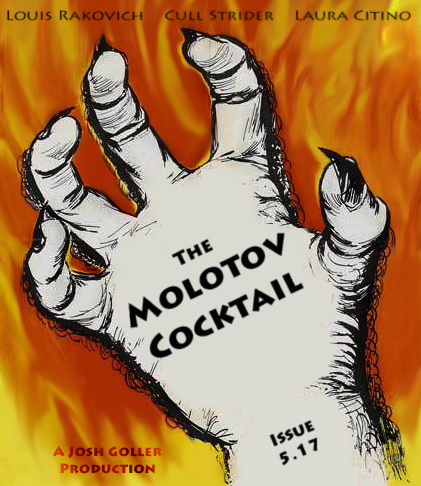 It was both the image and the opening editorial lines that drew me to this issue of The Molotov Cocktail: “Issue 5.17 will drag you to Hell.” Okay, I’m game. Self-defined as “A Projectile for Incendiary Flash Fiction,” the publication is produced by Josh Goller.
It was both the image and the opening editorial lines that drew me to this issue of The Molotov Cocktail: “Issue 5.17 will drag you to Hell.” Okay, I’m game. Self-defined as “A Projectile for Incendiary Flash Fiction,” the publication is produced by Josh Goller.
The “Think-Feel” of Writing
 Melissa R. Sipin, winner of the 2013 Glimmer Train Fiction Open, offers a craft essay in the Glimmer Train Bulletin #95 entitled “To My Unknown Daughter: On the Inheritance of Writing.” Sipin writes raw what so many writers struggle through in coming to their craft – their work – of writing, “I know, if you are anything like me, you will fight with society like a lover. In your writing, your art, you will need to expose its unwillingness to witness its oppression, its loneliness, its refusal to see truth and its addiction to shadows. And if you are anything like me, the world outside, which is both beautiful and not, both loving and not, both happy and sad, will force you to be sensitive to its pangs and joys, allowing you to think-feel. What is to think-feel?” And then later answers with, “This sensitivity, this ability to think-feel is what makes us writers, the kind of writers with the disposition to know and feel the most extreme states of the human condition (birth, love, and death). And it is because of this that we enter into these liminal spaces alone. We suffer these extreme states to know what loneliness feels like, what sadness, happiness, trauma, and hope are, both in body, mind, and spirit.”
Melissa R. Sipin, winner of the 2013 Glimmer Train Fiction Open, offers a craft essay in the Glimmer Train Bulletin #95 entitled “To My Unknown Daughter: On the Inheritance of Writing.” Sipin writes raw what so many writers struggle through in coming to their craft – their work – of writing, “I know, if you are anything like me, you will fight with society like a lover. In your writing, your art, you will need to expose its unwillingness to witness its oppression, its loneliness, its refusal to see truth and its addiction to shadows. And if you are anything like me, the world outside, which is both beautiful and not, both loving and not, both happy and sad, will force you to be sensitive to its pangs and joys, allowing you to think-feel. What is to think-feel?” And then later answers with, “This sensitivity, this ability to think-feel is what makes us writers, the kind of writers with the disposition to know and feel the most extreme states of the human condition (birth, love, and death). And it is because of this that we enter into these liminal spaces alone. We suffer these extreme states to know what loneliness feels like, what sadness, happiness, trauma, and hope are, both in body, mind, and spirit.”
The Glimmer Train Bulletin is a free monthly that features craft essays from writers published in recent issues of Glimmer Train Stories. Also included in #95 are essays by Selena Anderson (“Want”), George Saunders (“On the Preconceptual World”), and Rowena Macdonald (“Writing Dialogue”). Read them all here.
Lit Mag Covers :: Picks of the Week

This issue of Banipal: Magazine of Modern Arab Literature, features a celebration of Saadi Youssef, beginning with this striking portrait on the cover painted by Mansour Mansour.
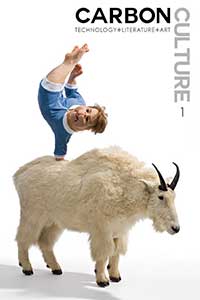
This cover image on Carbon Culture Review: Techology + Literature + Art is certainly an eye-catcher for its debut issue. Patricia Piccinini’s “The Strength of One Arm (With Canadian Mountain Goat)” is composed of silicone, fiberglass, human hair, clothing, and – yes – Canadian Mountain Goat.
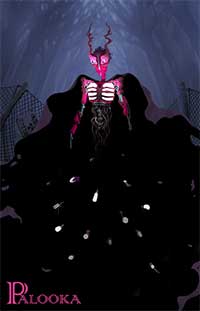
Palooka‘s newest issue (#5) features “Our Bright New Hope” by artist Florian Bo. The theme of light in the dark a fitting one as we approach the longest night of the year – winter solstice.
Atlanta Review Poetry Issue
The Fall/Winter 2014 issue of Atlanta Review is the Poetry 2014 issue, featuring just under 50 poets and just over 50 poems. Of these, 22 of the poets and their poems were selected for the International Publication Prize from the journal’s annual contest. And one selected above all others as the Grand Prize winner: Joyce Meyers.
Each Fall Issue includes at least 20 Publication Prize winners from their International Poetry Competition with one named for the grand prize cash award of $1000. Every Spring Issue of Atlanta Review includes an International Feature with poets from a different country or continent. The feature for spring 2015: Russia.
Glimmer Train Family Matters Winners :: 2014
Glimmer Train has just chosen the winning stories for their September Family Matters competition. This competition is held twice a year and is open to all writers for stories about family of all configurations. The next Family Matters competition will take place in March. Glimmer Train’s monthly submission calendar may be viewed here.
 First place: Rowena Macdonald, of London, UK, wins $1500 for “My Brother Is Back.” Her story will be published in Issue 96 of Glimmer Train Stories. [Photo credit: Martin Fuller.]
First place: Rowena Macdonald, of London, UK, wins $1500 for “My Brother Is Back.” Her story will be published in Issue 96 of Glimmer Train Stories. [Photo credit: Martin Fuller.]
Second place: Joshua Graber, of Canton, OH, wins $500 for “Freeman Göttschall Experiences One or Two More or Less Improbably Events.” His story will also be published in an upcoming issue of Glimmer Train Stories, increasing his prize to $700.
Third place: Janet Kim, of Cambridge, MA, wins $300 for “Teeth.”
A PDF of the Top 25 winners can be found here.
Sierra Nevada Young Writers Contest Winners
Sierra Nevada College’s English Program has released the winners of the 5th annual High School Writing Contest, a national competition which honors high school juniors and seniors in three categories: creative nonfiction, fiction and poetry. The winners in each category receive a cash prize of $500 for first place, $250 for second and $100 for third, and the $100 Local’s Prize honors student writers from Nevada and California. The winners also receive a $20,000 scholarship offer from SNC and consideration for publication in the Sierra Nevada Review, a literary annual which publishes poetry, fiction, and nonfiction by emerging and nationally recognized authors.
The Winners
Creative Nonfiction
First Place: Lindsay Emi (Westlake Village, CA), “Latin Class in Seven (VII) Parts”
Second Place: Darla Macel Anne Canales (Erie, CO), “Oven”
Third Place: Gabriel Braunstein (Arlington MA), “Family on the Commuter Rail”
Local’s Prize: Isabella Stenvall (San Luis Obispo CA), “Wars with Numbers”
Finalists: Emily Zhang, Oriana Tang, Aletheia Wang, Jack Priessman, Annie Harmon
Fiction
First Place: Emily Zhang (Boyds MA), “Midwestern Myth”
Second Place: Lucy Silbaugh (Wyncote PA), “Burrowing”
Third Place: Laura Ingram (Disputanta VA), “Absolute Value”
Local’s Prize: Erin Stoodley (Ventura CA), “Ghosts”
Finalists: Lindsay Emi, Jessica Li, Tatiana Saleh, Madison Hoffman, Oriana Tang
Poetry
First Place: Oriana Tang (Livingston NJ), “Bildungsroman”
Second Place: Catherine Valdez (Miami FL), “Mami”
Third Place: Ruohan Miao (Chandler AZ), “Dust Bowl”
Local’s Prize: Ava Goga (Reno NV), “Notes on Repression”
Finalists: Emily Zhang, Katia Kozachok, Allie Spensley, Emma Symmonds, Jessica Prescott
Remembering James Foley
 Meat for Tea editor Elizabeth MacDuffie has dedicated the opening pages of the most recent issue (v8 n3) in memory of Jim Foley.
Meat for Tea editor Elizabeth MacDuffie has dedicated the opening pages of the most recent issue (v8 n3) in memory of Jim Foley.
MacDuffe writes, “I remember him thusly: Jim came into the [UMass] grad English program a few years after I did. He was in the MFA program and I was in the Ph.D. program, but his was a pleasant presence in the hallways, and we discussed lesson plans and teaching ideas on a number of occasions. I knew him to be a thoughtful, caring, teacher and a smiling, kind, person. I was more of a friend of friend to him . . . Still, I knew him well enough to admire his courageous actions and to be devastated by his violent, untimely death. I can only imagine the pain his family is enduring and I humbly hope that giving them an issue of the magazine celebrating the man he was helps ease their pain in some small way.”
Writers contributing to the memorial include Molly Crabapple, Samantha Wood, Cathy K. Schlund-Vials, Connolly Ryan Tracy Cummings, Tom Kealey, and Kristin Bock.
New Orleans Review COLLECTIBLE Edition
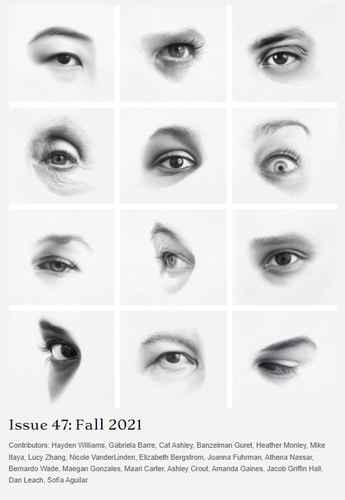 Volumes 40.1 & 40.2 / 2014 of the New Orleans Review are amazing, gorgeous, so super cool and no doubt will be THE collectible edition of the year! As a fan of the unique and quality ephemeral, I nearly swooned when I pulled this out of the stacks – a box set of individual chapbooks in honor of “New Orleans Review’s 45-year history of publishing innovative work from around the world.”
Volumes 40.1 & 40.2 / 2014 of the New Orleans Review are amazing, gorgeous, so super cool and no doubt will be THE collectible edition of the year! As a fan of the unique and quality ephemeral, I nearly swooned when I pulled this out of the stacks – a box set of individual chapbooks in honor of “New Orleans Review’s 45-year history of publishing innovative work from around the world.”
The seven books include: Because You’re Mine by Cassie Condrey, the 2013 Walker Percy Prize in Short Fiction selected by Christine Wiltz; Starbaby Blooms A Tuber Rose by Tessa Fontaine; A is for Afterimage by Christine Hamm; Literature for Nonhumans by Gabriel Gudding; Two Stories by Luis de Lión (tr. Silvia Juarez-Gomez & Nathan C Henne); Circus Freaks by Ana María Shua (tr. Steven J. Stewart); and Wastoid by Mathias Svalina.
The publication can be purchased via the publication’s website – but hurry. Their issues often sell out, and I imagine this one won’t last.
Lit Mag Covers :: Picks of the Week
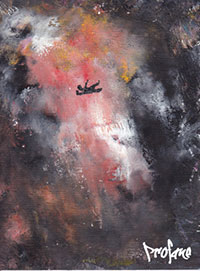
This inaugural issue of Profane Literary Journal features “A Feeling of Freedom” by W. Jack Savage, a painting with such rich texture it makes it appear as if the cover is actually canvas.
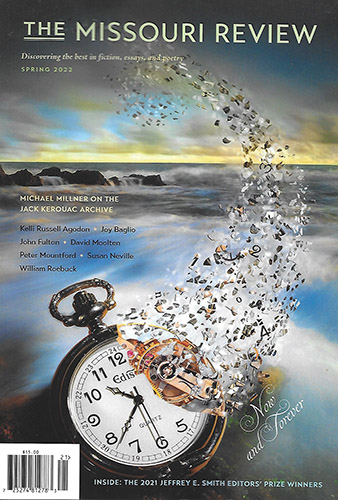
Each time I look at this cover, I can’t help but hear the song “These Boots Are Made For Walkin’.” They’re not boots, actually, but shoes with pant legs, and a crowd of little people as the shadow of each footstep. The piece is Karma by Do Ho Suh (2003; Urethane paint on fiberglass and resin; 153 1/2 x 118 x 291 inches) and is a fitting image for the theme of the Fall 2014 issue of The Missouri Review: Ultra-Violence.
Giving College Admins What They Deserve
Issue 10 of Saranac Review marks a decade that this annual of the SUNY College at Plattsburgh Department of English and Writing Arts Programs has been publishing. “No easy task,” remarks J.L. Torres in the Editor’s Notes. Torres mentions “then Provost Robert Golden, who secured budgetary support for the journal” in its infancy.
I’m glad Torres names Provost Golden. Such support as this is crucial for an academic publication to survive. A decade or so ago, I heard remarks from independent journal editors about how “easy” academic literary magazines had it because their funding was secure. I knew first hand this wasn’t true. At one college, I founded and led the college’s literary journal, and hoped the fact a key administrator’s daughter was in a creative writing program would offer us some of that mythical security. It did not. The journal was pitted against the outdoor club for an annual scrap of funding, and lost. Seems our administrator enjoyed hiking more than reading.
Then the recession hit, and college administrators nationwide went after every penny they could seize. Literary magazines make easy targets: seemingly “frivolous” and non-essential, especially publishing works those in decision-making roles find difficult to understand, if they read them at all. Numerous times, NewPages went to bat for these threatened publications, writing letters on their behalf to presidents, deans, provosts, and encouraging others to do the same. Yet we watched them fall. (Isotope, I still miss you!)
I listened to the shift in conversation, to editors talking about removing publications from their academic homes in order to save them, to find their own means of secure funding, and to be able to control the content (another long-standing battle that can occur in academic settings). I watched publications move online, either under pressure from an administration that believed this meant the journal would be “free” to publish, or from editors simply trying to save the publication with this less expensive format (usually along with the loss of their stipends, release time, office space, support staff, etc.). This was a risky move since, at that time, online publications were considered suspect in terms of credibility and stigmatized as “lower quality.”
The challenge continues, in this day and age of STEM not only is the focus on science, technology, engineering and math in education, but people in these fields tend to come with deep pockets that can support all kinds of initiatives (like new multimillion dollar campus buildings). Still, I am encouraged by the number of times I see STEAM as the emerging acronym, including “the arts” as being as vitally important to the creative process and on equal ground when it comes to critical thinking and developing the “whole” human being. It is an inclusion and partnering that is essential. The goal now is to continue encouraging and working with those in positions of decision making and power over the purse strings to see the value in the arts as much as those supporters of STEAM do, and as much as we do.
I don’t know former Provost Robert Golden, but he has my respect, as do all chairs, deans, provosts, vice presidents, and presidents who support the arts at their schools – not just in words, but in the cold, hard cash necessary to keep the arts alive and vibrant, as whole and as valid as any other aspect of academic study, professional and human development.
I recently attended the anniversary of a famous American composer who came back to his former college to celebrate with the former college president. I listened to speeches about how the arts were funded and supported at the school. I watched colleagues and community members give this former president a standing ovation. I’m sure he wasn’t a perfect president in his day, but whatever his faults may have been at the time, they hadn’t followed him into the future. I wondered about other college presidents, how they might be remembered years after they retired. I can imagine the Saranac Review having a 10th anniversary celebration and Robert Golden being invited. I can imagine that he, along with those currently in positions of power, would receive a standing ovation for their continued support of the publication.
It’s good to be recognized. If there are those at your college who have shown support in the past and in the present, I hope that you will take the opportunity to recognize them. Have some event where they are invited. Initiate a standing ovation to them. If you’re online, maybe you can find some way to create a virtual standing ovation. It doesn’t mean there haven’t been and won’t be struggles to survive, but don’t let their good efforts go unrecognized. I think those who have not done likewise should know the recognition they’ve lost, the respect they will never experience ten years, twenty years, thirty years later. I have seen that over time, people have not forgotten this good work. Those in positions now should see what they can choose to continue or not, what their own legacy could be.
Verso Live Jour- nal
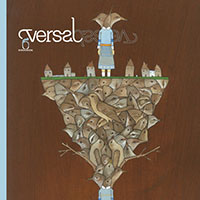 Amsterdam-based Versal literary journal went on “intermission” last year, which Editor Megan Garr soundly defends does not mean the publication is dead. To the contrary, Versal is achieving goals they had set for their downtime (though selling out the back issues is still on the To Do List – which you all could help with!). In a bold step forward and away from their past, Versal has started a super cool new venture: Verso / live jour- nal which “renders the literary journal in live form.” Each curated edition will feature one editor and one writer, and a selection of artists and thinkers in various forms: interviews, essays, slideshows, film, sound, and more. Each live issue is themed and edited: 1.1 “Hold Your Tongue” ed. Megan Garr; 1.2 “A Good Road to Follow” ed. Daniel J. Cecil; 1.3 “Chain Gang” ed. Anna Arov; 1.4 “Bad Dog” ed. Jane Lewty. Such a cool idea, but no surprise coming from Versal!
Amsterdam-based Versal literary journal went on “intermission” last year, which Editor Megan Garr soundly defends does not mean the publication is dead. To the contrary, Versal is achieving goals they had set for their downtime (though selling out the back issues is still on the To Do List – which you all could help with!). In a bold step forward and away from their past, Versal has started a super cool new venture: Verso / live jour- nal which “renders the literary journal in live form.” Each curated edition will feature one editor and one writer, and a selection of artists and thinkers in various forms: interviews, essays, slideshows, film, sound, and more. Each live issue is themed and edited: 1.1 “Hold Your Tongue” ed. Megan Garr; 1.2 “A Good Road to Follow” ed. Daniel J. Cecil; 1.3 “Chain Gang” ed. Anna Arov; 1.4 “Bad Dog” ed. Jane Lewty. Such a cool idea, but no surprise coming from Versal!
Lit Mag Covers :: Picks of the Week
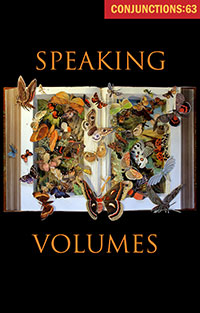
Issue 63 of Conjunctions is themed “Speaking Volumes,” and Kerry Miller’s mixed media piece Brehm Djurens Liv (Animal Life) does just that in its visual imagery.
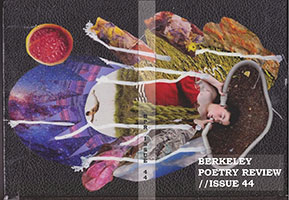
To continue the theme of speaking, subtle ceiling is credited for this cover image on issue 44 of Berkeley Poetry Review. The tumblr account, subtleceling.tumbler.com is credited to carolina, a “mixed media maker of things” from California now in Gotenburg, Sweden. The issue itself features many works that create a “collage of discrepant (and sometimes discordant) voices . . . “
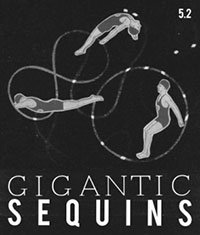
This cover image for Gigantic Sequins #52 seemed a natural flow from BPR. And likewise, a natural from book designer, poet, and artist Meg Willing.
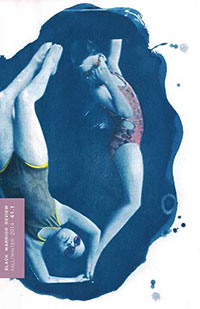
And then this nice, natural flow of images to the cover of Black Warrior Review (Fall/Winter 2014): Nager in Cyan by Summer Johnson. Sometimes, these lit mag cover features just take on a thematic flow of their own.
Hudson Review New Writers Issue
 The newest issue of The Hudson Review (Autumn 2014) is their New Writers Issue and features essays by Mara Naselli, James Santel, fiction by Asako Serizawa, Edward Porter, Lauren Schenkman, and poetry by Cally Conan-Davies, William Louis-Dreyfus, Trent Busch, Katherine Robinson, Guillermo Bleichmar, Anne Nance, and Susan de Sola. Some of the works can be read in full on the journal’s website.
The newest issue of The Hudson Review (Autumn 2014) is their New Writers Issue and features essays by Mara Naselli, James Santel, fiction by Asako Serizawa, Edward Porter, Lauren Schenkman, and poetry by Cally Conan-Davies, William Louis-Dreyfus, Trent Busch, Katherine Robinson, Guillermo Bleichmar, Anne Nance, and Susan de Sola. Some of the works can be read in full on the journal’s website.
25 Books That Inspired the World
 As part of World Literature Today magazine’s November 2014 cover feature focusing on central European literature since the fall of the Berlin Wall, the editors invited 25 writers to nominate one book that most influenced their own writing or ways of seeing the world. Nominations were open to any book-length work—written in any language and published since November 1989—as long as it could be read in English. The longlist was then published on WLT’s blog, and readers were invited to vote for their three favorites. The top ten results, along with the nominating statements for the three winning titles, can be found in the most recent issue and on their website.
As part of World Literature Today magazine’s November 2014 cover feature focusing on central European literature since the fall of the Berlin Wall, the editors invited 25 writers to nominate one book that most influenced their own writing or ways of seeing the world. Nominations were open to any book-length work—written in any language and published since November 1989—as long as it could be read in English. The longlist was then published on WLT’s blog, and readers were invited to vote for their three favorites. The top ten results, along with the nominating statements for the three winning titles, can be found in the most recent issue and on their website.
Fiddlehead Remembers Alistair MacLeod
The Autumn 2014 (No. 261) issue of Fiddlehead features “Remembering Alistair MacLeod.” Editorials by Ross Leckie (“Remembering Alistair MacLeod”), Mark Anthony Jarman (“A Master in the Heart of Cork”), Douglas Gibson (“A Great Writer and a Great Man”), and D.R. MacDonald (“Alistair MacLeod Tribute”). Immediately following this section is a work of fiction by Alistair MacLeod, “The Vastness of the Dark.”
Lit Mag Covers :: Picks of the Week

Can I politely say there’s just something compellingly creepy about this image on the November 2014 issue of Poetry that make it difficult to look away? Considering the image, I think that’s a compliment to the artist’s intention, expressed as well in the title of the work, “Entanglement Practice” (2011) by Lise Haller Baggesen.

East Coast Ink covers reflect the theme of each issue, a visual interpretation that can be both challenging and enjoyable. In issue 4, the editors note: “we explored bridges and connections of all kinds, whether they’re being built or burned.” The next issue: Bones.
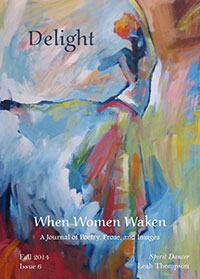
The Fall 2014 cover of the online journal When Women Waken features Spirit Dancer, a beautifully flowing painted image by Leah Thompson, who says, “My art is about passion. The subject I choose whether figurative or floral is second to my passion for the application of paint and color.” Read more about Leah here.
New Reading Series at Talking Writing
 Talking Writing welcomes writer and teacher Wm. Anthony Connolly to its staff as the new reading series editor. “He’ll scan the world of small-press print literary work for great pieces to republish in Talking Writing,” write the editors on the blog. Starting with the current issue, there will be several selections in each issue. The current issue, Fall 2014 “Money,” features a book excerpt by William Least Heat-Moon of Writing Blue Highways and a prose poem excerpt by Kim Triedman from Hadestown.
Talking Writing welcomes writer and teacher Wm. Anthony Connolly to its staff as the new reading series editor. “He’ll scan the world of small-press print literary work for great pieces to republish in Talking Writing,” write the editors on the blog. Starting with the current issue, there will be several selections in each issue. The current issue, Fall 2014 “Money,” features a book excerpt by William Least Heat-Moon of Writing Blue Highways and a prose poem excerpt by Kim Triedman from Hadestown.
Poems & Literal Truth
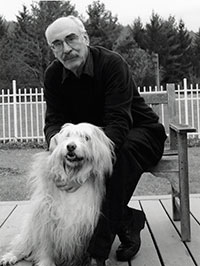 The Fall 2014 issue of New Ohio Review includes the feature “Poems and Literal Truth” with essays from Lawrence Raab (“Should Poems Tell the Truth?” [pictured]), Daisy Fried (“Truthless Demands”), Adrienne Su (“Where Are You Really Writing From? Reading and Writing Place and Experience”), Louise Glück (“A Brief Response” which begins “Frankly, I have no idea why this should be any sort of problem.”), Carl Dennis (“Telling the Truth in Poetry”), Kim Addonizio (“Pants on Fire”), and Michael Ryan (in which Ryan shares his experience reading through poems for Iowa Review – one of which came in with the title “Father”).
The Fall 2014 issue of New Ohio Review includes the feature “Poems and Literal Truth” with essays from Lawrence Raab (“Should Poems Tell the Truth?” [pictured]), Daisy Fried (“Truthless Demands”), Adrienne Su (“Where Are You Really Writing From? Reading and Writing Place and Experience”), Louise Glück (“A Brief Response” which begins “Frankly, I have no idea why this should be any sort of problem.”), Carl Dennis (“Telling the Truth in Poetry”), Kim Addonizio (“Pants on Fire”), and Michael Ryan (in which Ryan shares his experience reading through poems for Iowa Review – one of which came in with the title “Father”).
Denver Quarterly: Honoring Sand Creek
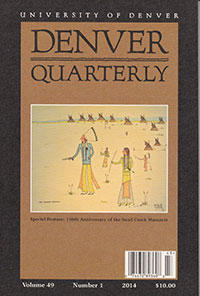 The newest issue of The Denver Quarterly (49.1 2014) includes a special feature of work by a selection of Native American writers to mark the 150th anniversary of the infamous Sand Creek Massacre (Laird Hunt, Editor). Editors Billy J. Stratton and Eleni Sikelianos write, “The words that make up this special feature are indeed limited, and as we look through the contents we wonder how to best honor the dead of Sand Creek and their living descendants. Yet we did not request that contributors send work specifically about Sand Creek. Some of the writers in this feature are working directly with history and some are not, but in all lives the desire to ‘write back’ and share story and song.”
The newest issue of The Denver Quarterly (49.1 2014) includes a special feature of work by a selection of Native American writers to mark the 150th anniversary of the infamous Sand Creek Massacre (Laird Hunt, Editor). Editors Billy J. Stratton and Eleni Sikelianos write, “The words that make up this special feature are indeed limited, and as we look through the contents we wonder how to best honor the dead of Sand Creek and their living descendants. Yet we did not request that contributors send work specifically about Sand Creek. Some of the writers in this feature are working directly with history and some are not, but in all lives the desire to ‘write back’ and share story and song.”
Lit Mag Covers :: Picks of the Week
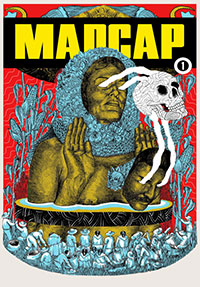
Madcap Review semiannual of literature and art makes its debut online with this cover image: Ever, November 19, 1910, 2013. Screenprint made with the master printers of the Cabiros Workshops. Click here for more information on the cover artwork.
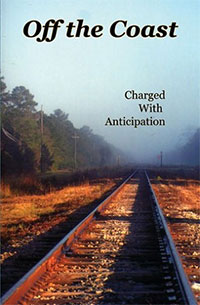 This photograph, “Longings,” by Malinda Fillingim graces the cover of the Fall 2014 poetry journal Off the Coast. It almost seemed to glimmer gold when caught in just the right light, and there’s just something about it that makes me want to be wandering down those tracks, into the fog.
This photograph, “Longings,” by Malinda Fillingim graces the cover of the Fall 2014 poetry journal Off the Coast. It almost seemed to glimmer gold when caught in just the right light, and there’s just something about it that makes me want to be wandering down those tracks, into the fog.
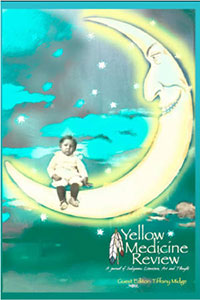 As a lifetime fan of the movie, Paper Moon, I was of course struck by this image Fall 2014 cover image for Yellow Medicine Review: “Boy in the Moon” by Hulleah Tsinhnahjinne. Though the moon seems a bit sinister at first glance, the more I absorbed the image, the more of the “protector” I could envision in the story of this image.
As a lifetime fan of the movie, Paper Moon, I was of course struck by this image Fall 2014 cover image for Yellow Medicine Review: “Boy in the Moon” by Hulleah Tsinhnahjinne. Though the moon seems a bit sinister at first glance, the more I absorbed the image, the more of the “protector” I could envision in the story of this image.Poetica Holocaust Edition
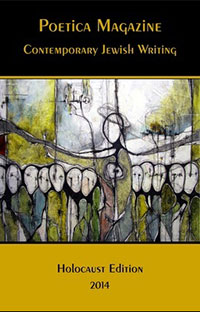 Although the fall edition of Poetica: Contemporary Jewish Writing is already sold out, readers can still get a copy of the publication’s special fall 2014 Holocaust Edition. Fiction and poetry from writers included in this edition: Sally Albiso, Fred Amram, Helen Eisen, Joy Gaines-Friedler, Barbara Goldberg, Miriam Green (Israel), Sarah Katz, Marta Kosály, Bem Le Hunte (Australia), Jesse Morales, Drew Nacht, Baruch November, Nina Pick, Michael Robinson, Sophie Soil (Canada), Tamara Tabel, Tim Stobierski, Israel Zoberman, with cover art by Ron Weijers and inside art by Selma Waldman and Harriet Caldwell. The publication is 70 pages, perfect bound.
Although the fall edition of Poetica: Contemporary Jewish Writing is already sold out, readers can still get a copy of the publication’s special fall 2014 Holocaust Edition. Fiction and poetry from writers included in this edition: Sally Albiso, Fred Amram, Helen Eisen, Joy Gaines-Friedler, Barbara Goldberg, Miriam Green (Israel), Sarah Katz, Marta Kosály, Bem Le Hunte (Australia), Jesse Morales, Drew Nacht, Baruch November, Nina Pick, Michael Robinson, Sophie Soil (Canada), Tamara Tabel, Tim Stobierski, Israel Zoberman, with cover art by Ron Weijers and inside art by Selma Waldman and Harriet Caldwell. The publication is 70 pages, perfect bound.
John Thornton Williams on Revealing Character
 Revealing the interiority of a character in a way that feels natural, yet resonates powerfully within a reader is one of the most difficult tasks of the fiction writer. Considering how powerful that emotional connection between reader and character can prove to be, and how empty a story can feel without it, it’s vital that the writer bridge the distance between reader and character in ways that are subtle rather than clumsy.
Revealing the interiority of a character in a way that feels natural, yet resonates powerfully within a reader is one of the most difficult tasks of the fiction writer. Considering how powerful that emotional connection between reader and character can prove to be, and how empty a story can feel without it, it’s vital that the writer bridge the distance between reader and character in ways that are subtle rather than clumsy.
But how does one accomplish it?
John Thornton Williams goes on to explain in his November Glimmer Train Newsletter bulletin Indirection of Image.
Other craft essays include:
Aurelie Sheehan: My City (or, On the Idea of Making It My Own)
Peter Turchi: Puzzle and Mystery
Greg Schreur: The Creative Process: A Diuretic Metaphor
New Ohio Review 2014 Contest Winners
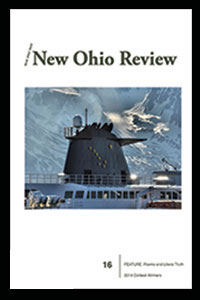 Issue #16 / Fall 2014 of New Ohio Review features the 2014 Contest Winners as selected by Aimee Bender for Fiction and Alan Shapiro for Poetry:
Issue #16 / Fall 2014 of New Ohio Review features the 2014 Contest Winners as selected by Aimee Bender for Fiction and Alan Shapiro for Poetry:
Fiction Prizes
1st – Robert Glick: “The Undersized Negative”
2nd – Joseph Scapellato: “Small Boy”
Poetry Prizes
1st – Stephanie Horvath: “So That is What I Am,” “CadesCove Water Wheel,” and “Medicine”
2nd – Jennifer Perrine: “A Theory of Violence” and “Embarrassment: from baraço (halter)”
matchbook’s New Editor
Co-founding Editor of matchbook Edward Mullany is taking leave at the magazine. He originally developed the idea for the publication, aided in the design, and “was a driving force for so much of the great work we have had the pleasure and honor to publish.” You can still follow what he is doing on his blog, The Other Notebook.
R. B. Pillay will be stepping up as matchbook’s new editor. “R. B. Pillay is a fantastic fiction writer and artists himself and matchbook is lucky to have him. After all, he’s originally from Cleveland. We hope you will look him up and send anonymous love notes,” write the editors. Pillay will also be in charge of social media for the magazine.
Zombie Talk: An Interview with Susanna Kearsley
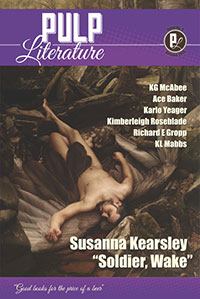 The most recent issue of Pulp Literature (#4 Autumn 2014) features the story “Soldier, Wake” by Susanna Kearsley followed by an interview in which Kearsely comments: “My books are a marketing department’s nightmare, really, because they don’t fit tidily into any genre . . . But usually I simply tell people I write stories about present-day people who are dealing with mysteries that come from the past, with dual plot lines that weave a historical tale with a modern one.” Kearsely goes on to discuss “Soldier, Wake,” her first zombie story, why she thinks readers are drawn to the mystical, and using her international travel as research for her writing
The most recent issue of Pulp Literature (#4 Autumn 2014) features the story “Soldier, Wake” by Susanna Kearsley followed by an interview in which Kearsely comments: “My books are a marketing department’s nightmare, really, because they don’t fit tidily into any genre . . . But usually I simply tell people I write stories about present-day people who are dealing with mysteries that come from the past, with dual plot lines that weave a historical tale with a modern one.” Kearsely goes on to discuss “Soldier, Wake,” her first zombie story, why she thinks readers are drawn to the mystical, and using her international travel as research for her writing
Special Feature on Lara Gularte
 The Bitter Oleander‘s latest issue contains a special feature on Lara Gularte which includes a bio, interview, and selection of her poetry. Born in 1947 and raised in San Jose, California, Gularte has a unique family history as well as an accomplished self history. In the interview, she speaks much to how her experiences growing up influenced her life as a writer: “I remember having an active imagination that grew greater due to my isolation and no other children to socialize with. . . . I was so used to amusing myself and spending time with adults, grade school was a formidable experience. However, my love of reading stories never waned.” By high school, she was interested in “Beat Poets” and had the opportunity to buy a book of poetry from and meet Lawrence Ferlinghetti. She participated in demonstrations and was part of the counter culture movement. More influences include working in human services, participating in a group called “Waverly Writers,” attending Community of Writers Squaw Valley Workshop, and going to the DISQUIET International Literary Program in Lisbon, Portugal.
The Bitter Oleander‘s latest issue contains a special feature on Lara Gularte which includes a bio, interview, and selection of her poetry. Born in 1947 and raised in San Jose, California, Gularte has a unique family history as well as an accomplished self history. In the interview, she speaks much to how her experiences growing up influenced her life as a writer: “I remember having an active imagination that grew greater due to my isolation and no other children to socialize with. . . . I was so used to amusing myself and spending time with adults, grade school was a formidable experience. However, my love of reading stories never waned.” By high school, she was interested in “Beat Poets” and had the opportunity to buy a book of poetry from and meet Lawrence Ferlinghetti. She participated in demonstrations and was part of the counter culture movement. More influences include working in human services, participating in a group called “Waverly Writers,” attending Community of Writers Squaw Valley Workshop, and going to the DISQUIET International Literary Program in Lisbon, Portugal.
In response to the question in which Gularte admits is “very thought provoking and not easy to answer”—”Your poems are enriched by an imagism . . . and a solitude that summons both the natural world and the consciousness that helps complete your oneness with it . . . How do you manage to keep it awake inside yourself?”—Gularte writes, “I look at writing poetry as mining, going into my unconscious to draw out what is there and make sense of it . . . I can enter the unconscious easily at any time. However, I must be quiet and not have busy activities to do. From my unconscious I retrieve images. I am a visual person and find putting images to words is satisfying for me. Before I write a poem I retrieve many images from my unconscious and describe these images on paper. I then put the images together to make some kind of sense. I never know what will come of it. I arrange words with a result that usually surprises me. I like to be surprised.”
Here’s a sample of some of her work. The poem is titled “Cassandra Visits the Azores”:
She roams the stone islands,
sees the future through basaltic rock-
flowings, wrinkled crevasses, hardened fluids.Her milky eyes never shut.
She wears a necklace of black stones,
these stones she throws in the sea,
and fishing boats, surface.The folding and unfolding
of what she sees turns her inward,
sand and tears stream down her face.The sky of wayward gray slides like lava,
light changing,
changing moments.Water spills over the caldera.
Lit Mag Covers :: Picks of the Week
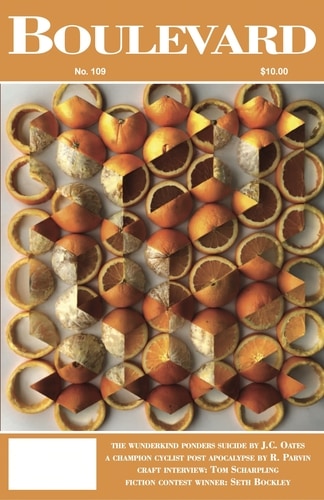
Boulevard consistently selects stunning cover art, and the most recent issue (#88) shows no letting up. Steven Kenny’s “The Raft” is an oil on canvas, richly reproduced for the rich depth of contents within (like Bob Hicok, Sheila Kohler, Joyce Carol Oates, and Floyd Skloot).

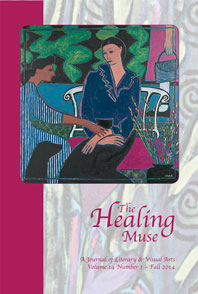 I love the concept of The Healing Muse, published by the Center for Bioethics and Humanities, SUNY Medical University. This journal should be required reading for ALL health care worker programs nationwide. The cover alone is testament to its contents, issue after issue: “Comforting a Friend” by Lynne Feldman. The Healing Muse – keeping the humanities in medicine.
I love the concept of The Healing Muse, published by the Center for Bioethics and Humanities, SUNY Medical University. This journal should be required reading for ALL health care worker programs nationwide. The cover alone is testament to its contents, issue after issue: “Comforting a Friend” by Lynne Feldman. The Healing Muse – keeping the humanities in medicine.
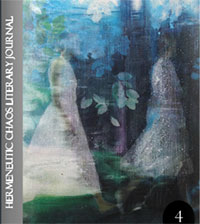 Mia Funk‘s oil on canvas “Labyrinth” draws readers into issue #4 of Hermeneutic Chaos Literary Journal. Funk says of her work: “I try to be provocative and playful and create a visually impacting work using oil on canvas, moving the paint like a dream/nightmare until I’m satisfied with the effect of the images coming through. I think people have a capacity now to accept strange and I hope some of my work holds up to that. I want to disorientate the viewer and make the unfamiliar familiar and vice versa.”
Mia Funk‘s oil on canvas “Labyrinth” draws readers into issue #4 of Hermeneutic Chaos Literary Journal. Funk says of her work: “I try to be provocative and playful and create a visually impacting work using oil on canvas, moving the paint like a dream/nightmare until I’m satisfied with the effect of the images coming through. I think people have a capacity now to accept strange and I hope some of my work holds up to that. I want to disorientate the viewer and make the unfamiliar familiar and vice versa.”
Nimrod Awards Issue
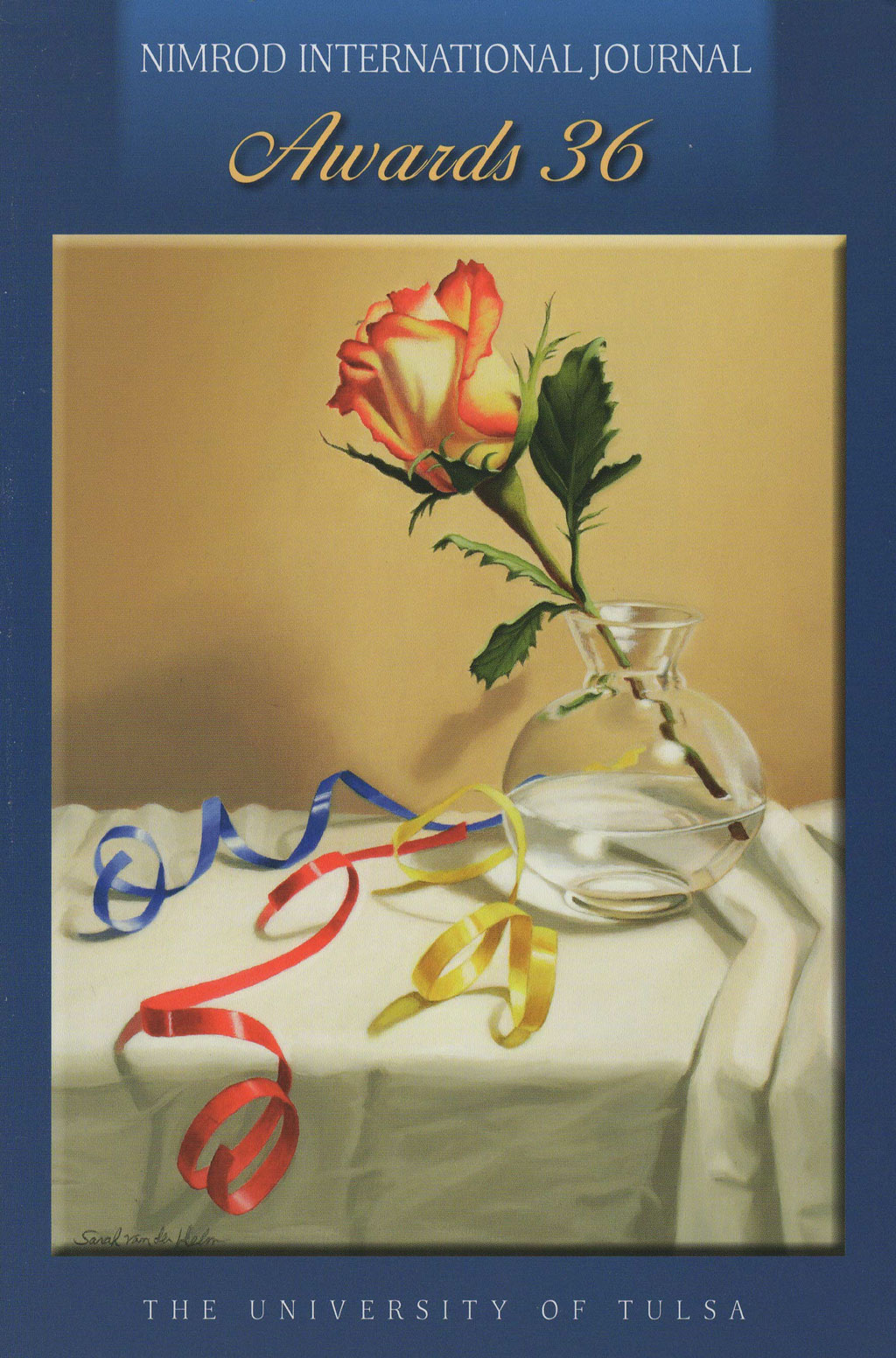 Every year, Nimrod puts out a special issue dedicated to that year’s awards: The Katherine Anne Porter Prize for Fiction and The Pablo Neruda Prize for Poetry. This fall, Nimrod honors the selections made by fiction judge Chris Abani and poetry judge W. S. Di Piero. “The winning stories and poems display a breadth of style and creativity, each one unique in its approach to its subject.”
Every year, Nimrod puts out a special issue dedicated to that year’s awards: The Katherine Anne Porter Prize for Fiction and The Pablo Neruda Prize for Poetry. This fall, Nimrod honors the selections made by fiction judge Chris Abani and poetry judge W. S. Di Piero. “The winning stories and poems display a breadth of style and creativity, each one unique in its approach to its subject.”
The Katherine Anne Porter Prize for Fiction
First Prize
Shobha Rao’s “Kavitha and Mustafa”
Second Prize
Jill Logan’s “Little House”
The Pablo Neruda Prize for Poetry
First Prize
Mary-Alice Daniel
Second Prize
Christopher Buckley
Interview with Cheryl Strayed in Booth
 Because of her large success with her creative nonfiction title Wild, Cheryl Strayed is greatly known in the writing world, and in the latest print issue of Booth, Ashley Petry talks with her “about telling hard truths, making pacts with your readers, and of course writing like a motherfucker.”
Because of her large success with her creative nonfiction title Wild, Cheryl Strayed is greatly known in the writing world, and in the latest print issue of Booth, Ashley Petry talks with her “about telling hard truths, making pacts with your readers, and of course writing like a motherfucker.”
In the interview, Strayed talks a lot about how it is to share truth in writing and the challenges that come along with it: “I always say, if you’re going to show anyone’s ass, it had better be your own. Memoir writing is about the journey of the self. It’s about saying, this is my subjective view of this experience, and that gives you an enormous amount of power. You get to say what’s true; you’re the god of that world. So I belive in searching my soul to tell the necessary truths, and sometimes that involves other people, but I always try to do it with a sense of compassion.”
In response to a question about what she gains from writing about difficult experiences, Strayed conveys that writing is her own kind of therapy: “I’ve been able to forgive and understand and accept many of the hardest things in my life via my writing. The fictional character in Torch who is the stepfather, Bruce, is based loosely on my own stepfather. There was no way I could get inside the consciousness of Bruce without loving Bruce, forgiving Bruce, and understanding why he did what he did. Once I did that, I understood why my stepfather did what he did, and it wasn’t about not loving me; it was about his own survival. Being able to step back from my own life by going deep into the life of literature has been healing over and over again. There’s this strange dichotomy where you have to go deeper into your life while also stepping back from it so that you can craft it into a book or an essay.”
The conversation wraps up with a thought from Strayed about the debate on if you need to live in NYC or have an MFA in order to be a writer: “I think that whole thing is so unbelievably ridiculous . . . What I say is, do the same thing as a writer that you do as a human, to seek out the people who inspire you, who comfort you, who challenge you, who enlighten you, who will offer you shelter when you need it and a push out the door when you need it. I root for real life.”
AQR & Genre Defiant Work
Flipping through the newest issue of Alaska Quarterly Review, from back to front, it only took a page in before I was stopped by the image on the page. I won’t explain it – has to be seen – “STRETCH IT OUT!” by Vis-à-Vis Society (Rachel Kessler and Sierra Nelson). Guest edited with an introduction by Elizabeth Bradfield, “Out of Bounds: A Celebration of Genre-Defiant Work” is pretty dang delightful. While AQR tries to bring it onto the page, the one piece connected directly from their website is really better in the e-version than in print. It’s worth having it preserved in the issue, though both forms seem transient to their own degree, but “The Christmas When You Were Nine” is best experienced in its originally paced “code poem” form. But this is the challenge of works that defy genre, and is nothing new, Bradfield tells us: “Work that defies genre and authorship is not, of course, new. Japanese renga of the 8th century were written collaboratively. One might consider Homer a mashup artist, making his poem from the many tellings and retellings of an oral epic. French Surrealists mixed visual art into their experiments. The ‘happenings’ of the 1950s and 1960s were even more multi-disciplinary and worked to break the fourth wall between performer and audience.” And what was once strange and new became mainstream. Strange and new, fun and playful, definitely worth checking out – with kudos to Alaska Quarterly Review for making efforts to harness that defiance for us to see – or have they harnessed the readers and brought them to this experience? Defiance indeed.
Lit Mag Covers :: Picks of the Week
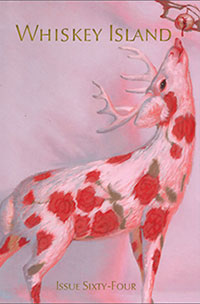
If you wonder how we pick Lit Mag Covers of the Week, it really is just looking at the issue and catching ourselves saying, “Oh, that’s a cool!” Exactly what I said when I picked up Whiskey Island issue 64. St. Paul, Minnesota painter Aniela Sobieski, also an MFA candidate at Syracuse University, has her work “Young Buck,” oil on canvas, featured on the cover. While still gorgeous, it’s not quite in full. Visit her website for the whole picture.
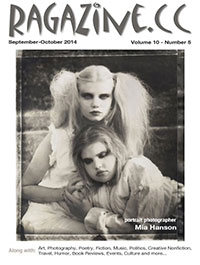
This September/October 2014 cover of Ragzine had been showing up on our slider feature, and each time, I am absolutely drawn to this image. “Ida & Disa” is a photo by Mia Hanson whose interview is included in this issue online.
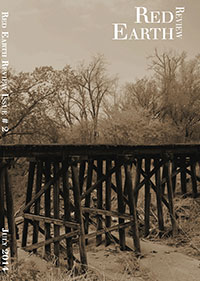
Number 2 Summer 2014 of Red Earth Review struck me because I recognize that precarious-looking train trestel trusted to hold up a ton of freight through wooded swamp. We have a few of those near where I live, in addition to reminding me of the film scene from Stand By Me. “People Get Ready” is the photograph by Wilma Whittaker.

2013 Newman Prize for Chinese Literature
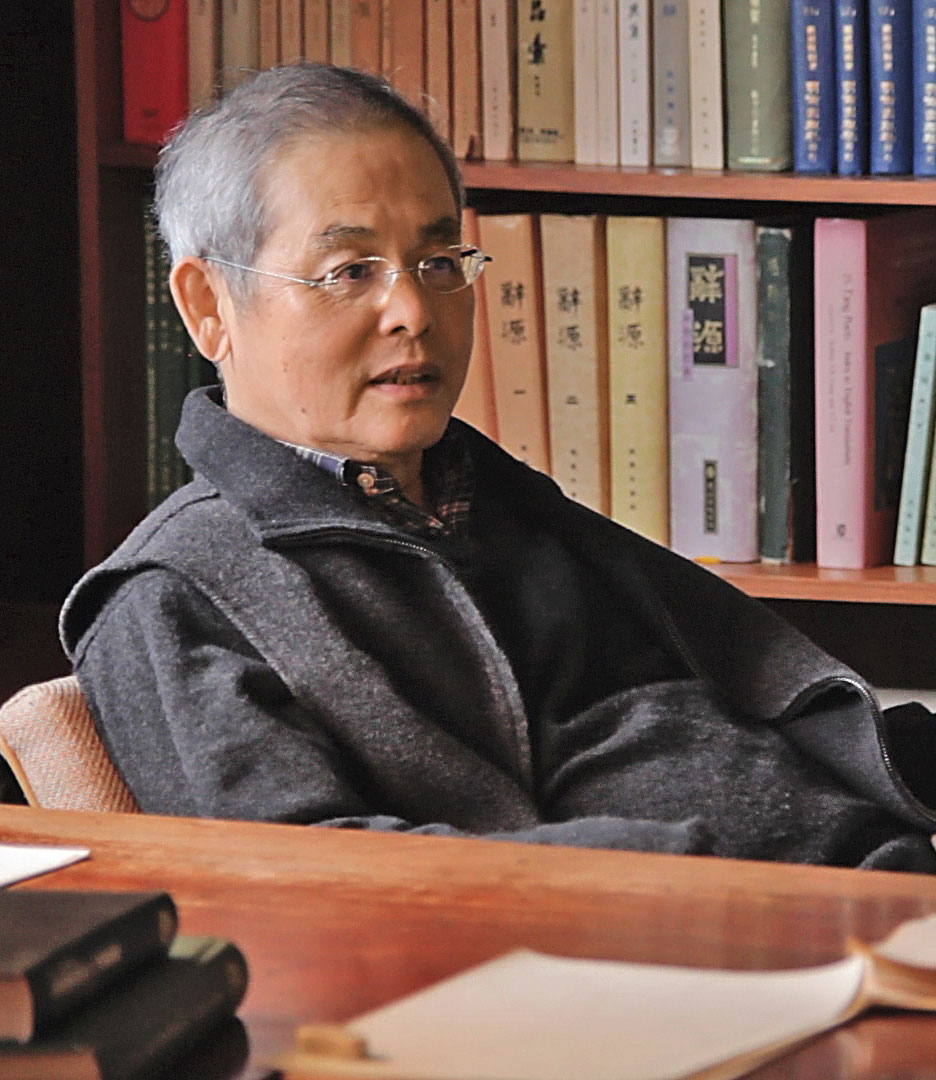 “The Newman Prize for Chinese Literature is awarded biennially in recognition of outstanding achievement in prose or poetry that best captures the human condition, and is conferred solely on the basis of literary merit.” The winner for 2013 is Yang Mu, and the recent issue of Chinese Literature Today includes a special feature on the writer, including poetry by Yang Mu and an interview.
“The Newman Prize for Chinese Literature is awarded biennially in recognition of outstanding achievement in prose or poetry that best captures the human condition, and is conferred solely on the basis of literary merit.” The winner for 2013 is Yang Mu, and the recent issue of Chinese Literature Today includes a special feature on the writer, including poetry by Yang Mu and an interview.
Here is a short bio from Chinese Literature Today, and you can read a few of his poems on their website: Yang Mu was born in 1940 in the small coastal city of Huilan in east Taiwan as Ching-hsien Wang 珙씀獻. He received his BA in English from Tunghai University in Taiwan, his MFA from the University of Iowa, and his PhD in comparative literature from the University of California at Berkeley. He has taught at many universities in North America, Taiwan, and Hong Kong, but he spent most of his academic career at the University of Washington, Seattle. He has also served in important administrative positions, including the founding dean of the School of Humanities and Social Sciences at the National Dong Hwa University in his hometown of Hualian and the founding director of the Institute of Literature and Philosophy at Academia Sinica, the premiere national research institution in Taiwan. He currently holds an endowed chair at Dong Hwa.
Yang Mu has been writing poetry continuously for sixty years. The longevity of his career is matched by his extraordinary creativity, which has exerted a transformative influence on Taiwanese poetry in general from the 1950s to the present. His poetry assimilates the best that the Chinese and the Western traditions have to offer, deftly blending classicism and surrealism, romanticism and modernism. His poetry may be lyrical or dramatic, contemplative or defiant, elegiac or erotic. In an age when poetry is indisputably considered to be minority literature, Yang Mu enjoys enduring popularity among readers of several generations. His accomplishments beyond the realm of poetry are demonstrable in prose, literary criticism, scholarship on classical Chinese poetry, comparative literature, and editing, as well as the translation of poetry.
Yang Mu has been married to Ying-ying Hsia for thirty-five years; they have a son, Bruce. The couple now lives in Taiwan most of the year, dividing their time between Hualian and Taipei.
Word Trucks Feed the Mind
I appreciate Robert S. Fogarty’s humorous but hard-hitting editorial in the newest issue of The Antioch Review, “Word Trucks: I and You; Here and There; This and That.” In this “nation of fads,” he writes, one is hard pressed to keep up with all of them.” Fogarty goes on to discuss the food truck phenomenon – how in his foreign travels he had been warned against eating from street vendors, and now, here in the US, those curbside eateries are all the rage. He muses, “Literary magazines have been in the food truck business for a long time, serving up a variety of dishes that were intended to stimulate the intellectural palate with ‘the best words in the best order.'” [Qtd Coleridge] While Nicholas Carr looks at “What the Internet is Doing to Our Brains” in his book The Shallows, quoting a Duke University instructor who says she can’t get students to read “whole books anymore,” Fogarty seems unshaken – his stronghold in the “word truck” realm has long been feeding hungry minds to satisfaction. “A heady meal,” he claims – “and it’s gluten free.”
2014 Raymond Carver Contest Winners
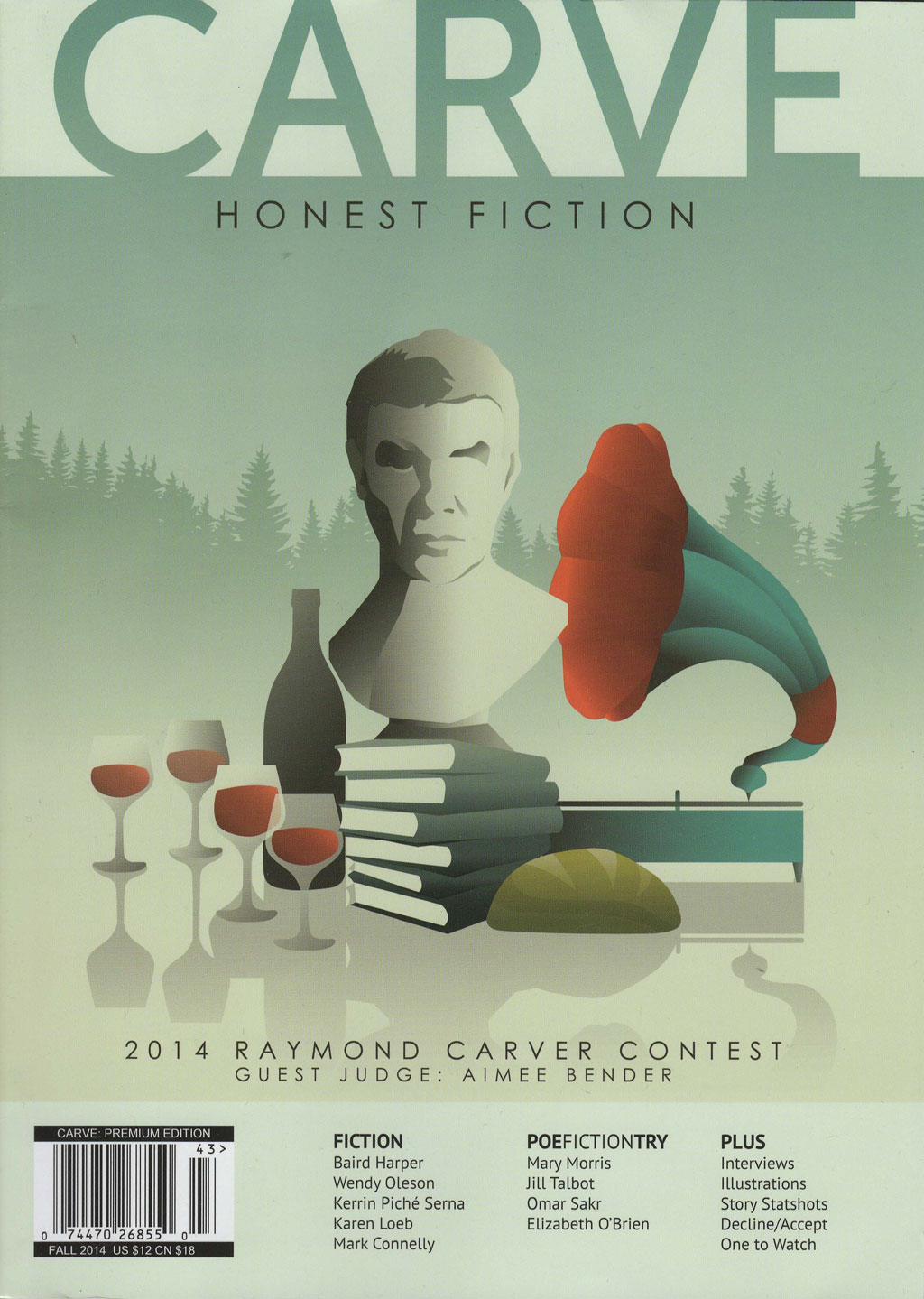 The latest issue of Carve features the winners of the 15th annual Raymond Carver Contest. This year, author Aimee Bender was the guest judge. “Bender’s inspiring stories showed me how exciting and powerful the short story form can be if you just play with the words andi mages and rhythms the right way,” writes Editor-in-Chief Matthew Limpede. “It is truly an honor that she accepted our invitation to guest judge.”
The latest issue of Carve features the winners of the 15th annual Raymond Carver Contest. This year, author Aimee Bender was the guest judge. “Bender’s inspiring stories showed me how exciting and powerful the short story form can be if you just play with the words andi mages and rhythms the right way,” writes Editor-in-Chief Matthew Limpede. “It is truly an honor that she accepted our invitation to guest judge.”
First Place
“Safe, Somewhere” by Baird Harper
From Aimee Bender: “Loved how this story was weird in such a quiet way… That lurking sense of menace that people connect to Carver is very real here. Well-written and distinct unto itself.”
Second Place
“The Snow Children” by Wendy Oleson
From Aimee Bender: “An open and lively child’s voice and a fluid feel to the prose—taking on big issues through the bewilderment and sensitivity of a kid’s point of view.”
Third Place
“Martha and Other Anomalies” by Kerrin Piché Serna
From Aimee Bender: “Captures well Martha’s feelings of returning new and different into a world that is not sure about what to do with her.”
Editor’s Choice (Kristin S. Vannamen)
“Cantaloupe” by Karen Loeb
From the editors: “Karen’s story, ‘Cantaloupe,’ takes a simple piece of fruit and infuses it with rich meaning against the backdrop of Japanese culture.”
Editor’s Choice (Matthew Limpede)
“Entra’acte” by Mark Connelly
Lit Mag Covers :: Picks of the Week
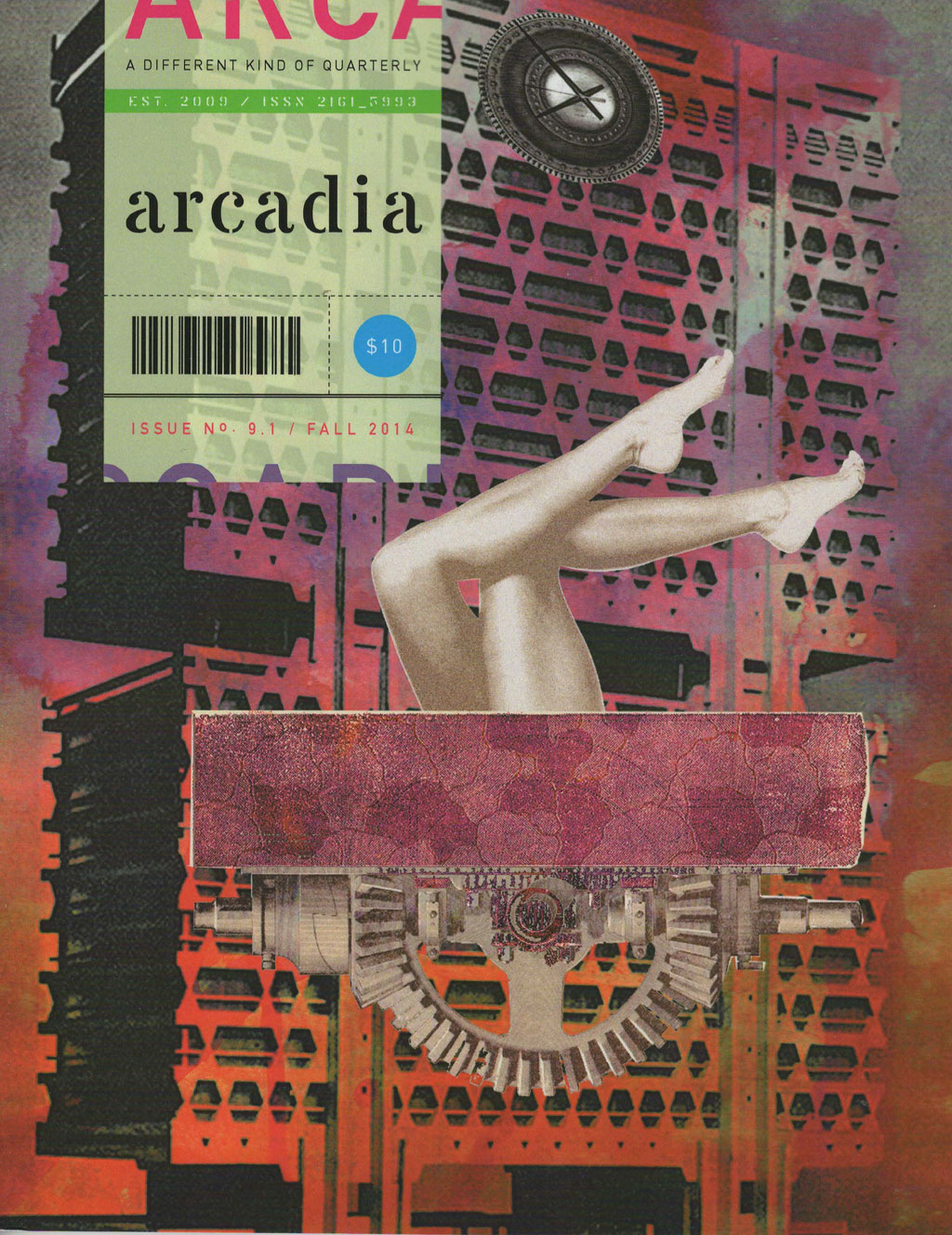
Arcadia‘s cover issue, as well as a selection included art within the issue, comes from Tammy Brummel, a freelance graphic designer in Oklahoma City. “My process involves compiling a library of photos and layering them on backgrounds,” she writes. “I then add graphics along with other elements until they begin to react with one another and built a story.”
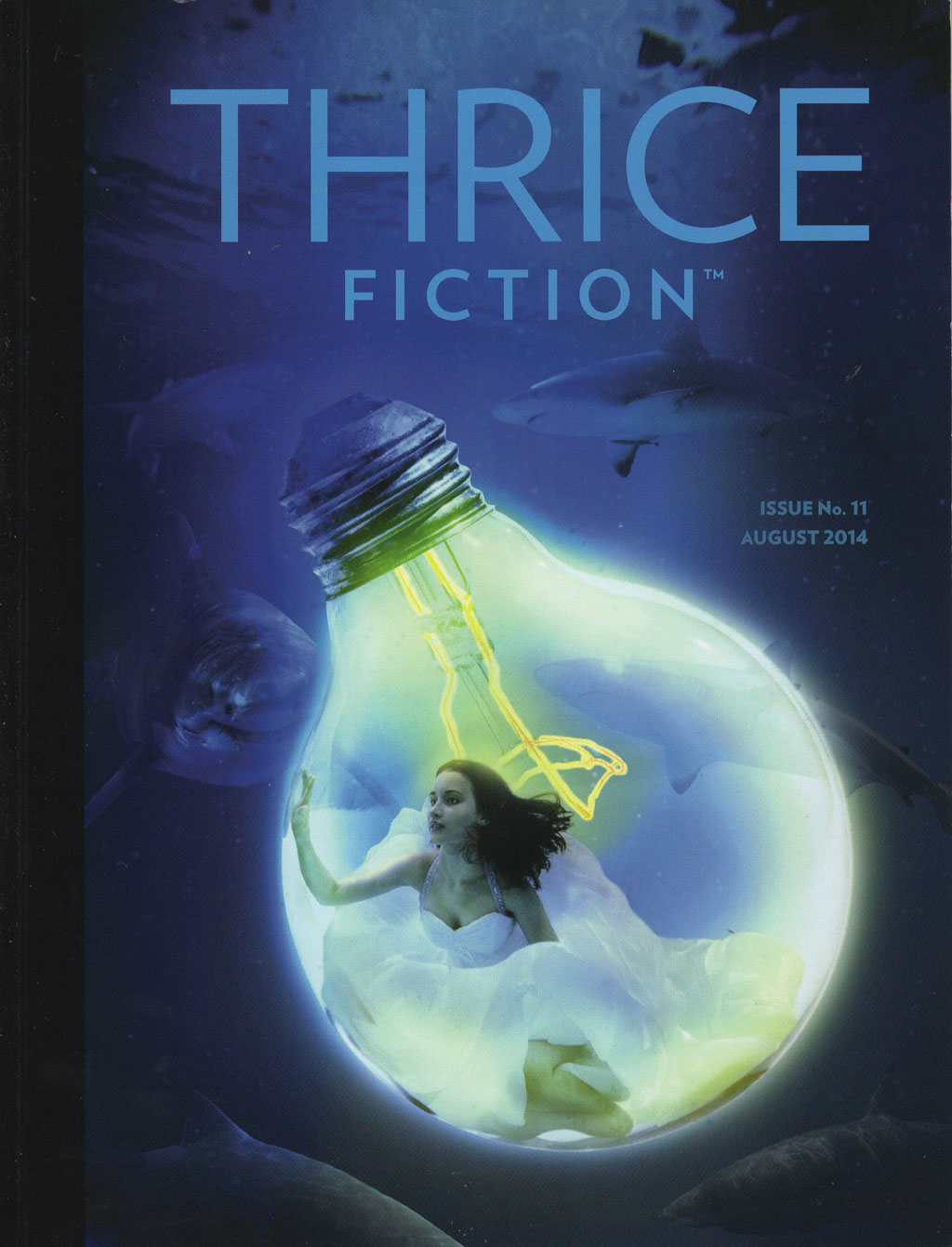
Katelin Kinney contributes the cover art for the latest print edition of Thrice Fiction. She uses the methods learned from her BFAs in fine art painting and fine art photography to “create digital paintings where photos begin to morph into surreal worlds of fantasy and conceptual dramatizations.
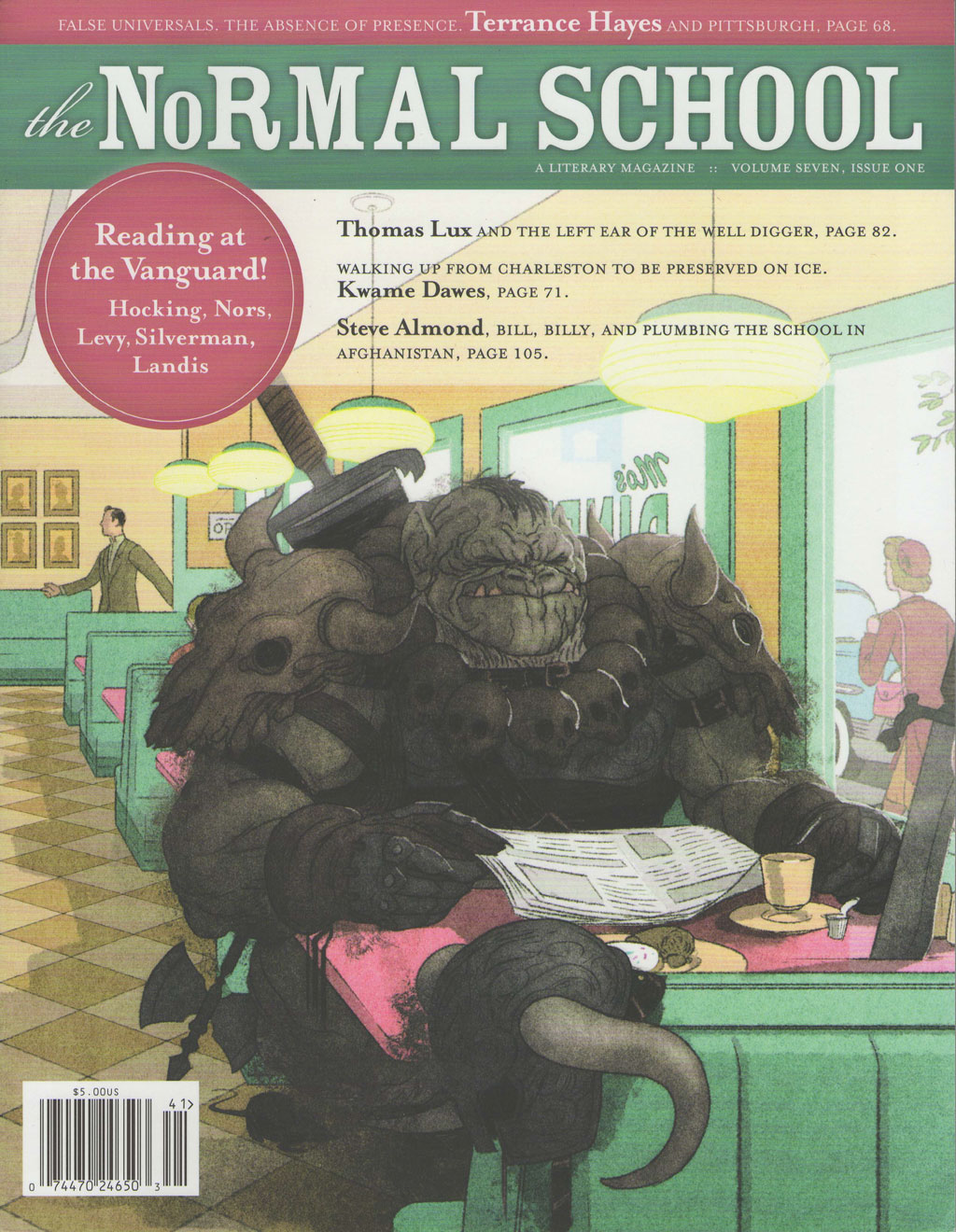
Morgan Schweitzer created this cover art especially for The Normal School. “We stumbled on his work for another magazine and flattered him relentlessly until he agreed to do our cover,” write the editors. “A longtime pro in animation and commercial illustration, he has a ton of range, so when we cut him loose on the cover we didn’t really know what style would emerge, only that we were going to be excited about it.”
Glimmer Train Award for New Writers Winners
Glimmer Train has just chosen the winning stories for their August Short Story Award for New Writers. This competition is held quarterly and is open to all writers whose fiction has not appeared in a print publication with a circulation greater than 5000. The next Short Story Award competition will take place in August. Glimmer Train’s monthly submission calendar may be viewed here.
 1st place goes to John Thornton Williams [pictured] of Laramie, WY. He wins $1500 for “Darling, Keith, The Subway Girl, and Jumping Joe Henry” and his story will be published in Issue 95 of Glimmer Train Stories. This will be his first print publication.
1st place goes to John Thornton Williams [pictured] of Laramie, WY. He wins $1500 for “Darling, Keith, The Subway Girl, and Jumping Joe Henry” and his story will be published in Issue 95 of Glimmer Train Stories. This will be his first print publication.
2nd place goes to Stefan De La Garza of Fayetteville, AR. He wins $500 for “Chiaroscuro.”
3rd place goes to Laura Jok of Houston, TX. She wins $300 for “As It Were.”
A PDF of the Top 25 winners can be found here.
Deadline soon approaching! Very Short Fiction Award: October 31. This competition is held quarterly, and 1st place has been increased to $1500 plus publication in the journal. It’s open to all writers, with no theme restrictions, and the word count must not exceed 3000. Click here for complete guidelines.
Winners of The Enizagam Literary Contest
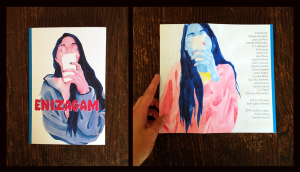 The latest volume of Enizagam, a literary journal edited, designed, and published by the high school students of the School of Literary Arts at Oakland School for the Arts, features the winners of their annual Literary Awards in Poetry and Fiction.
The latest volume of Enizagam, a literary journal edited, designed, and published by the high school students of the School of Literary Arts at Oakland School for the Arts, features the winners of their annual Literary Awards in Poetry and Fiction.
Poetry
Winner: Kat Harville
Finalists: Laura Jo Hess, Michael Mlekoday
Fiction
Winner: Mirene Arsanios
Finalists: Alma Garcia, Mary Kuryla
Of Arsanios’s short story, Daniel Alarcon writes: “Mirene Arsanios has written a dreamy, sultry gem of a story. “B” is about love and desire and growing up; about the power dynamic between two girls on the cusp of being young women. I was drawn in by the careful, supple language, and the poetic rendering of a scene that is both mesmeric and utterly real. Bravo!”
Of Harville’s poems Eileen Myles writes: “Kat Harville #1 for me. I love the intense verbiness. It’s wild stuff full of sprung energy, shrinking and pouncing, full of animals and animalism, full of pronouncements: I am the terrible vanilla and you….It’s brave, passionate, fun dark work that is running on its own honor, its own steam and it does not let up and I am never once disappointed in this work. She plays it to the end, a real poet.”
2014 Ekphrasis Prize Winner
 The Fall/Winter 2014 issue of Ekphrasis features the winner of the 2014 Ekphrasis Prize for Poetry, winning $500 and publication. Editors Laverne and Carol Frith announce that it was selected among “a very strong field of contenders.” The winner is Joseph Stanton for his “outstanding” poem “Thomas Dewing’s Lady with a Lute.” Here is a few stanzas from the beginning:
The Fall/Winter 2014 issue of Ekphrasis features the winner of the 2014 Ekphrasis Prize for Poetry, winning $500 and publication. Editors Laverne and Carol Frith announce that it was selected among “a very strong field of contenders.” The winner is Joseph Stanton for his “outstanding” poem “Thomas Dewing’s Lady with a Lute.” Here is a few stanzas from the beginning:
Dewing has a passion for the Lady with the lute
we cannot avoid
knowing that.
Though her almost classic face lifts to light
in full profile, her torso twists
ever so slightly
To show her décolleté,
her bosom surprisingly exposed
above her slender waist.
Men linger in front of this picture
in its corner of the National Gallery
till their wives pull them past.
“Geek Girls” issue of Room
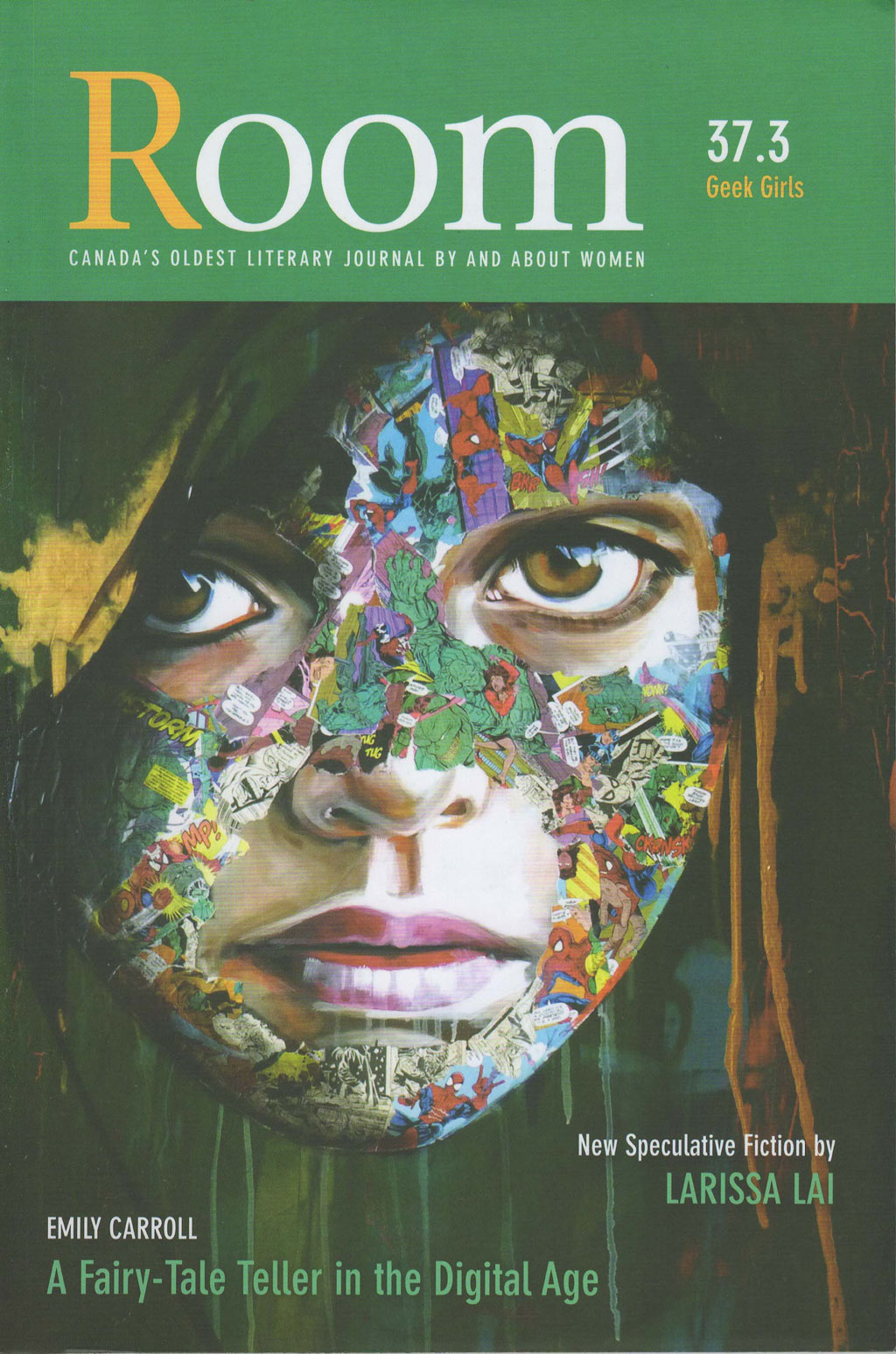 Paying full notice to the current phenomenon of women pretending to be geeks to attract males and “the insidious ‘Idiot Nerd Girl’ meme,” Meghan Bell introduces this special “Geek Girls” issue of Room to be in despite of all of “that noise.” She writes, “‘Geek Girls’ includes Buffy The Vampire Slayer and Torchwood fandom, poetry inspired by comic books and fairy tales, as well as new work by acclaimed speculative fiction author Larissa Lai, an interview with horror writer and illustrator Emily Caroll, and comic book-inspired artwork by Sandraw Chevrier. Hockey nerds slip ‘lightly homoerotic’ fan fiction into the hands of a Canucks player, biochemists attempt to fit in with mathematicians and physicists, experimentalists and theoreticians, skeletons come to life , and zombies fall in love.”
Paying full notice to the current phenomenon of women pretending to be geeks to attract males and “the insidious ‘Idiot Nerd Girl’ meme,” Meghan Bell introduces this special “Geek Girls” issue of Room to be in despite of all of “that noise.” She writes, “‘Geek Girls’ includes Buffy The Vampire Slayer and Torchwood fandom, poetry inspired by comic books and fairy tales, as well as new work by acclaimed speculative fiction author Larissa Lai, an interview with horror writer and illustrator Emily Caroll, and comic book-inspired artwork by Sandraw Chevrier. Hockey nerds slip ‘lightly homoerotic’ fan fiction into the hands of a Canucks player, biochemists attempt to fit in with mathematicians and physicists, experimentalists and theoreticians, skeletons come to life , and zombies fall in love.”
The cover, by Sandra Chevrier, is a perfect selection for this issue. The artist writes, “The cage series is about women trying to find freedom from society’s twisted preconceptions of what a woman should or shouldn’t be. The women encased in cages of brash, imposing paint or comic books that mask their very person symbolizes the struggle that women have with false expectations of beauty and perfection as well as the limitations society places on women, corrupting what truly is beautiful by placing women in prisons of identity. By doing so, society is asking them to become superheroes. I use collage or loose and heavy textures of paint that make the woman seem to be emerging from the surreal world within the canvas. A dance between reality and imagination, truth and deception.”
In an interview with Emily Carroll, the issue of women interested in “geek culture” being called fake is brought up. However, Carroll says she has never seemed to have a problem with the issue: “I don’t think I’ve ever really experienced being called a fake geek . . I have friends who have experienced it because I do have a lot of friends who are involved with video games. I hear reports of them being spoken down to or treated like they don’t actually play the game. It’s definitely a huge thing. I feel like I’m too much of a recluse to get the full brunt of it. Maybe it’s because I draw Dune fan art that nobody has ever questioned my Dune cred.
The Kenyon Review Transitions to Bimonthly
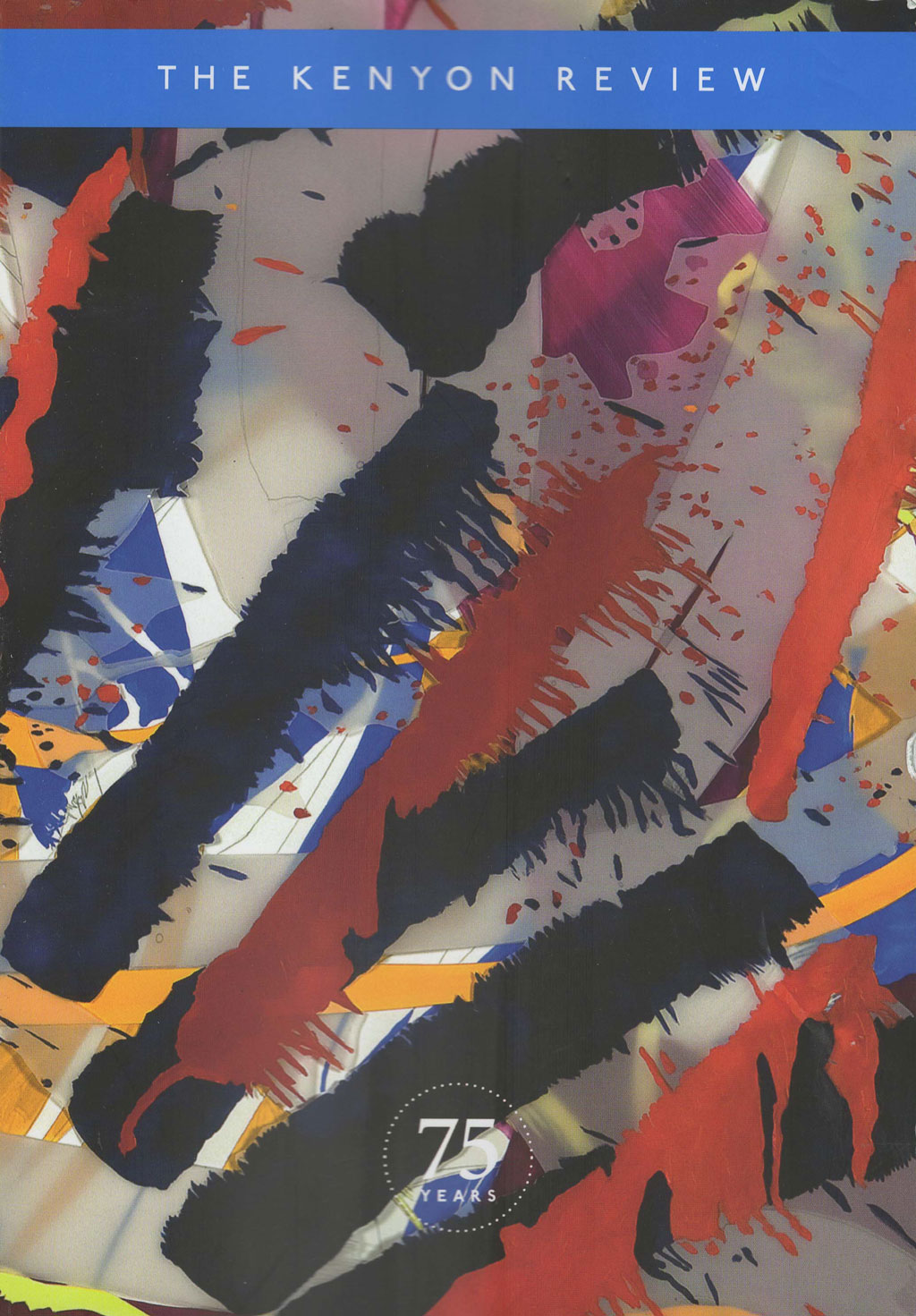 The most recent issue of The Kenyon Review will be the last one printed on the quarterly publication schedule as, after 75 years, the magazine transitions to a bimonthly schedule with six issues out each year instead of four. In addition, the issues will be slightly smaller so that they are easier to browse; “the format of the Review has come to feel rather unwieldy, even intimidating. It’s a lot of heft arriving everything three months,” writes Editor David H. Lynn. He writes that these plans have been in place for a while, and that they spent the last year working on an innovative design.
The most recent issue of The Kenyon Review will be the last one printed on the quarterly publication schedule as, after 75 years, the magazine transitions to a bimonthly schedule with six issues out each year instead of four. In addition, the issues will be slightly smaller so that they are easier to browse; “the format of the Review has come to feel rather unwieldy, even intimidating. It’s a lot of heft arriving everything three months,” writes Editor David H. Lynn. He writes that these plans have been in place for a while, and that they spent the last year working on an innovative design.
“The new Kenyon Review will be fresh and inviting,” promises Lynn. “…This reading is about pleasure, about relishing. But it will surely be easier to pick up one of these attractive, slender issues before bedtime or as you’re heading out the door. We’re surely not backing away from great writing, not relaxing our standards or our commitment one iota. Going forward, The Kenyon Review will faithfully publish literature that matters and to the standards we’ve proudly held all these years. Our future is brighter than ever.”
The current issue itself features the winners of the 2014 Kenyon Review Short Fiction Contests, a credo from Joyce Carol Oates, and a selection of fiction, nonfiction, poetry, and reviews.
Florida Review 2013 Editors’ Awards
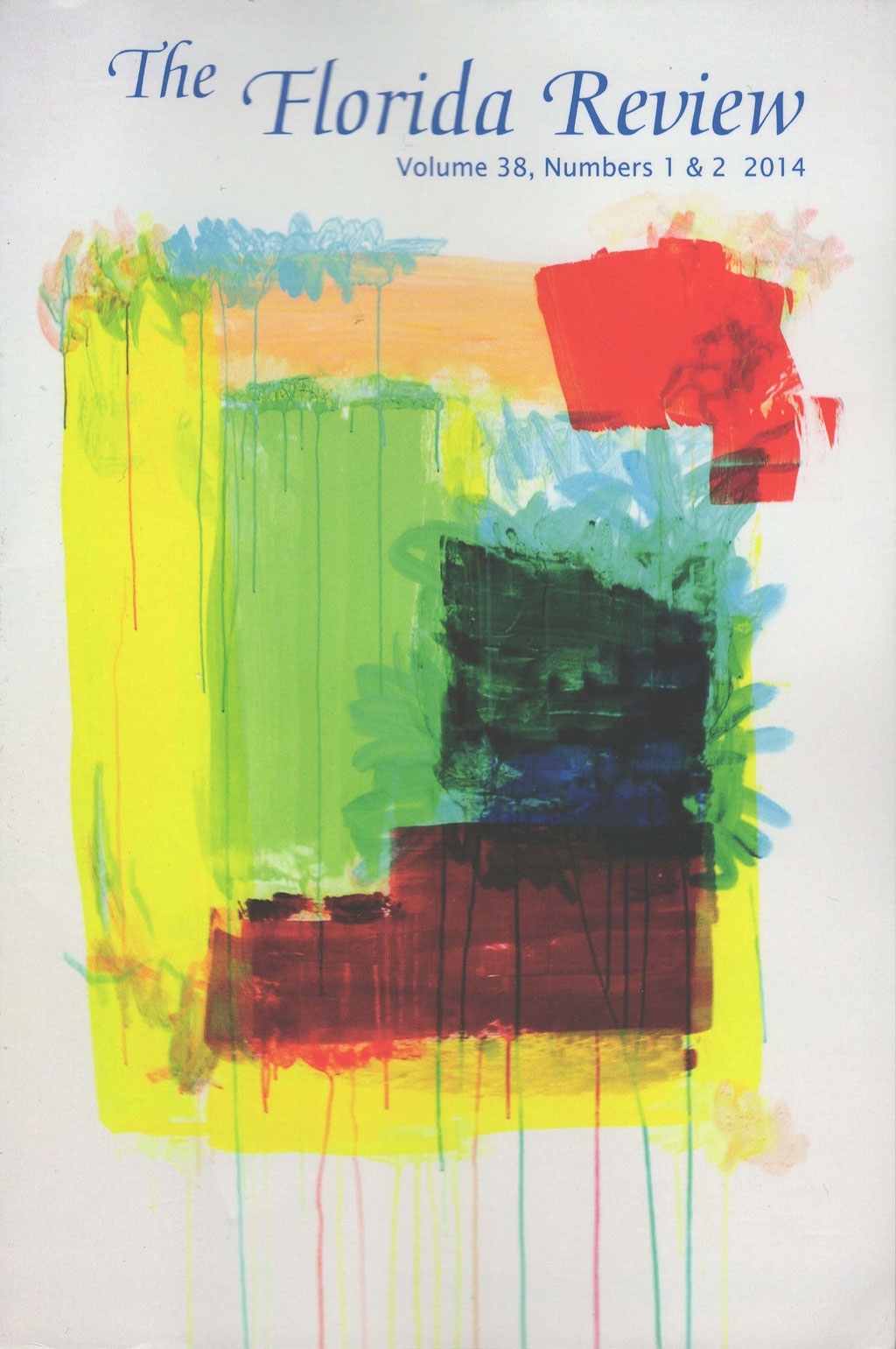 The current issue of Florida Review features the winners of the 2013 Editors’ Awards, which were awarded in essay, fiction, and poetry categories. As a new feature to this section, the editors invited the winners to contribute about “the creative genesis and evolution of their winning work.” Editor Jocelyn Bartkevicius writes, “Dan Reiter, whose story of Holocaust survivors, ‘All Your First Born,’ won the fiction award, tells of viewing a videotaped interview with his grandparents, who, unlike other family members of their generation did survive the Holocaust, and how their testimony inspired his writing. Lisa Lanser-Rose, whose braided essay, ‘Turnpike Psycho,’ revolves around a friend’s murder and her own harrowing encounter with a stalker, writes about transitioning from a simple retelling of a particular situation to an exploration of its deeper ramifications as a ‘story.’ John Blair, winner of the poetry award, writes of the links between his poems and history, autobiography, and memory, an eclectic continuum with such varied topics as atrocities in Somalia and Chechnya, the Roman Inquisition, leukemia, and hands-on labor in the garden.
The current issue of Florida Review features the winners of the 2013 Editors’ Awards, which were awarded in essay, fiction, and poetry categories. As a new feature to this section, the editors invited the winners to contribute about “the creative genesis and evolution of their winning work.” Editor Jocelyn Bartkevicius writes, “Dan Reiter, whose story of Holocaust survivors, ‘All Your First Born,’ won the fiction award, tells of viewing a videotaped interview with his grandparents, who, unlike other family members of their generation did survive the Holocaust, and how their testimony inspired his writing. Lisa Lanser-Rose, whose braided essay, ‘Turnpike Psycho,’ revolves around a friend’s murder and her own harrowing encounter with a stalker, writes about transitioning from a simple retelling of a particular situation to an exploration of its deeper ramifications as a ‘story.’ John Blair, winner of the poetry award, writes of the links between his poems and history, autobiography, and memory, an eclectic continuum with such varied topics as atrocities in Somalia and Chechnya, the Roman Inquisition, leukemia, and hands-on labor in the garden.
Essay Winner
Lisa Lanser-Rose: “Turnpike Psycho”
Essay Finalist
Tanya Bomsta: “Traditions”
Fiction Winner
Dan Reiter: “All Your Firstborn”
Fiction Finalist
Rachel Borup: “Crash”
Poetry Winner
John Blair: “The Lesser Poet,” “And Yet It Moves,” & “Dirt”
Poetry Finalist
Tanya Grae: “Like Darwin’s Finches,” “Verbal Abuse,” & “Cage Sonnet”

 The Winter 2014 issue of
The Winter 2014 issue of